The future of tourism: Bridging the labor gap, enhancing customer experience
As travel resumes and builds momentum, it’s becoming clear that tourism is resilient—there is an enduring desire to travel. Against all odds, international tourism rebounded in 2022: visitor numbers to Europe and the Middle East climbed to around 80 percent of 2019 levels, and the Americas recovered about 65 percent of prepandemic visitors 1 “Tourism set to return to pre-pandemic levels in some regions in 2023,” United Nations World Tourism Organization (UNWTO), January 17, 2023. —a number made more significant because it was reached without travelers from China, which had the world’s largest outbound travel market before the pandemic. 2 “ Outlook for China tourism 2023: Light at the end of the tunnel ,” McKinsey, May 9, 2023.
Recovery and growth are likely to continue. According to estimates from the World Tourism Organization (UNWTO) for 2023, international tourist arrivals could reach 80 to 95 percent of prepandemic levels depending on the extent of the economic slowdown, travel recovery in Asia–Pacific, and geopolitical tensions, among other factors. 3 “Tourism set to return to pre-pandemic levels in some regions in 2023,” United Nations World Tourism Organization (UNWTO), January 17, 2023. Similarly, the World Travel & Tourism Council (WTTC) forecasts that by the end of 2023, nearly half of the 185 countries in which the organization conducts research will have either recovered to prepandemic levels or be within 95 percent of full recovery. 4 “Global travel and tourism catapults into 2023 says WTTC,” World Travel & Tourism Council (WTTC), April 26, 2023.
Longer-term forecasts also point to optimism for the decade ahead. Travel and tourism GDP is predicted to grow, on average, at 5.8 percent a year between 2022 and 2032, outpacing the growth of the overall economy at an expected 2.7 percent a year. 5 Travel & Tourism economic impact 2022 , WTTC, August 2022.
So, is it all systems go for travel and tourism? Not really. The industry continues to face a prolonged and widespread labor shortage. After losing 62 million travel and tourism jobs in 2020, labor supply and demand remain out of balance. 6 “WTTC research reveals Travel & Tourism’s slow recovery is hitting jobs and growth worldwide,” World Travel & Tourism Council, October 6, 2021. Today, in the European Union, 11 percent of tourism jobs are likely to go unfilled; in the United States, that figure is 7 percent. 7 Travel & Tourism economic impact 2022 : Staff shortages, WTTC, August 2022.
There has been an exodus of tourism staff, particularly from customer-facing roles, to other sectors, and there is no sign that the industry will be able to bring all these people back. 8 Travel & Tourism economic impact 2022 : Staff shortages, WTTC, August 2022. Hotels, restaurants, cruises, airports, and airlines face staff shortages that can translate into operational, reputational, and financial difficulties. If unaddressed, these shortages may constrain the industry’s growth trajectory.
The current labor shortage may have its roots in factors related to the nature of work in the industry. Chronic workplace challenges, coupled with the effects of COVID-19, have culminated in an industry struggling to rebuild its workforce. Generally, tourism-related jobs are largely informal, partly due to high seasonality and weak regulation. And conditions such as excessively long working hours, low wages, a high turnover rate, and a lack of social protection tend to be most pronounced in an informal economy. Additionally, shift work, night work, and temporary or part-time employment are common in tourism.
The industry may need to revisit some fundamentals to build a far more sustainable future: either make the industry more attractive to talent (and put conditions in place to retain staff for longer periods) or improve products, services, and processes so that they complement existing staffing needs or solve existing pain points.
One solution could be to build a workforce with the mix of digital and interpersonal skills needed to keep up with travelers’ fast-changing requirements. The industry could make the most of available technology to provide customers with a digitally enhanced experience, resolve staff shortages, and improve working conditions.

Would you like to learn more about our Travel, Logistics & Infrastructure Practice ?
Complementing concierges with chatbots.
The pace of technological change has redefined customer expectations. Technology-driven services are often at customers’ fingertips, with no queues or waiting times. By contrast, the airport and airline disruption widely reported in the press over the summer of 2022 points to customers not receiving this same level of digital innovation when traveling.
Imagine the following travel experience: it’s 2035 and you start your long-awaited honeymoon to a tropical island. A virtual tour operator and a destination travel specialist booked your trip for you; you connected via videoconference to make your plans. Your itinerary was chosen with the support of generative AI , which analyzed your preferences, recommended personalized travel packages, and made real-time adjustments based on your feedback.
Before leaving home, you check in online and QR code your luggage. You travel to the airport by self-driving cab. After dropping off your luggage at the self-service counter, you pass through security and the biometric check. You access the premier lounge with the QR code on the airline’s loyalty card and help yourself to a glass of wine and a sandwich. After your flight, a prebooked, self-driving cab takes you to the resort. No need to check in—that was completed online ahead of time (including picking your room and making sure that the hotel’s virtual concierge arranged for red roses and a bottle of champagne to be delivered).
While your luggage is brought to the room by a baggage robot, your personal digital concierge presents the honeymoon itinerary with all the requested bookings. For the romantic dinner on the first night, you order your food via the restaurant app on the table and settle the bill likewise. So far, you’ve had very little human interaction. But at dinner, the sommelier chats with you in person about the wine. The next day, your sightseeing is made easier by the hotel app and digital guide—and you don’t get lost! With the aid of holographic technology, the virtual tour guide brings historical figures to life and takes your sightseeing experience to a whole new level. Then, as arranged, a local citizen meets you and takes you to their home to enjoy a local family dinner. The trip is seamless, there are no holdups or snags.
This scenario features less human interaction than a traditional trip—but it flows smoothly due to the underlying technology. The human interactions that do take place are authentic, meaningful, and add a special touch to the experience. This may be a far-fetched example, but the essence of the scenario is clear: use technology to ease typical travel pain points such as queues, misunderstandings, or misinformation, and elevate the quality of human interaction.
Travel with less human interaction may be considered a disruptive idea, as many travelers rely on and enjoy the human connection, the “service with a smile.” This will always be the case, but perhaps the time is right to think about bringing a digital experience into the mix. The industry may not need to depend exclusively on human beings to serve its customers. Perhaps the future of travel is physical, but digitally enhanced (and with a smile!).
Digital solutions are on the rise and can help bridge the labor gap
Digital innovation is improving customer experience across multiple industries. Car-sharing apps have overcome service-counter waiting times and endless paperwork that travelers traditionally had to cope with when renting a car. The same applies to time-consuming hotel check-in, check-out, and payment processes that can annoy weary customers. These pain points can be removed. For instance, in China, the Huazhu Hotels Group installed self-check-in kiosks that enable guests to check in or out in under 30 seconds. 9 “Huazhu Group targets lifestyle market opportunities,” ChinaTravelNews, May 27, 2021.
Technology meets hospitality
In 2019, Alibaba opened its FlyZoo Hotel in Huangzhou, described as a “290-room ultra-modern boutique, where technology meets hospitality.” 1 “Chinese e-commerce giant Alibaba has a hotel run almost entirely by robots that can serve food and fetch toiletries—take a look inside,” Business Insider, October 21, 2019; “FlyZoo Hotel: The hotel of the future or just more technology hype?,” Hotel Technology News, March 2019. The hotel was the first of its kind that instead of relying on traditional check-in and key card processes, allowed guests to manage reservations and make payments entirely from a mobile app, to check-in using self-service kiosks, and enter their rooms using facial-recognition technology.
The hotel is run almost entirely by robots that serve food and fetch toiletries and other sundries as needed. Each guest room has a voice-activated smart assistant to help guests with a variety of tasks, from adjusting the temperature, lights, curtains, and the TV to playing music and answering simple questions about the hotel and surroundings.
The hotel was developed by the company’s online travel platform, Fliggy, in tandem with Alibaba’s AI Labs and Alibaba Cloud technology with the goal of “leveraging cutting-edge tech to help transform the hospitality industry, one that keeps the sector current with the digital era we’re living in,” according to the company.
Adoption of some digitally enhanced services was accelerated during the pandemic in the quest for safer, contactless solutions. During the Winter Olympics in Beijing, a restaurant designed to keep physical contact to a minimum used a track system on the ceiling to deliver meals directly from the kitchen to the table. 10 “This Beijing Winter Games restaurant uses ceiling-based tracks,” Trendhunter, January 26, 2022. Customers around the world have become familiar with restaurants using apps to display menus, take orders, and accept payment, as well as hotels using robots to deliver luggage and room service (see sidebar “Technology meets hospitality”). Similarly, theme parks, cinemas, stadiums, and concert halls are deploying digital solutions such as facial recognition to optimize entrance control. Shanghai Disneyland, for example, offers annual pass holders the option to choose facial recognition to facilitate park entry. 11 “Facial recognition park entry,” Shanghai Disney Resort website.
Automation and digitization can also free up staff from attending to repetitive functions that could be handled more efficiently via an app and instead reserve the human touch for roles where staff can add the most value. For instance, technology can help customer-facing staff to provide a more personalized service. By accessing data analytics, frontline staff can have guests’ details and preferences at their fingertips. A trainee can become an experienced concierge in a short time, with the help of technology.
Apps and in-room tech: Unused market potential
According to Skift Research calculations, total revenue generated by guest apps and in-room technology in 2019 was approximately $293 million, including proprietary apps by hotel brands as well as third-party vendors. 1 “Hotel tech benchmark: Guest-facing technology 2022,” Skift Research, November 2022. The relatively low market penetration rate of this kind of tech points to around $2.4 billion in untapped revenue potential (exhibit).
Even though guest-facing technology is available—the kind that can facilitate contactless interactions and offer travelers convenience and personalized service—the industry is only beginning to explore its potential. A report by Skift Research shows that the hotel industry, in particular, has not tapped into tech’s potential. Only 11 percent of hotels and 25 percent of hotel rooms worldwide are supported by a hotel app or use in-room technology, and only 3 percent of hotels offer keyless entry. 12 “Hotel tech benchmark: Guest-facing technology 2022,” Skift Research, November 2022. Of the five types of technology examined (guest apps and in-room tech; virtual concierge; guest messaging and chatbots; digital check-in and kiosks; and keyless entry), all have relatively low market-penetration rates (see sidebar “Apps and in-room tech: Unused market potential”).
While apps, digitization, and new technology may be the answer to offering better customer experience, there is also the possibility that tourism may face competition from technological advances, particularly virtual experiences. Museums, attractions, and historical sites can be made interactive and, in some cases, more lifelike, through AR/VR technology that can enhance the physical travel experience by reconstructing historical places or events.
Up until now, tourism, arguably, was one of a few sectors that could not easily be replaced by tech. It was not possible to replicate the physical experience of traveling to another place. With the emerging metaverse , this might change. Travelers could potentially enjoy an event or experience from their sofa without any logistical snags, and without the commitment to traveling to another country for any length of time. For example, Google offers virtual tours of the Pyramids of Meroë in Sudan via an immersive online experience available in a range of languages. 13 Mariam Khaled Dabboussi, “Step into the Meroë pyramids with Google,” Google, May 17, 2022. And a crypto banking group, The BCB Group, has created a metaverse city that includes representations of some of the most visited destinations in the world, such as the Great Wall of China and the Statue of Liberty. According to BCB, the total cost of flights, transfers, and entry for all these landmarks would come to $7,600—while a virtual trip would cost just over $2. 14 “What impact can the Metaverse have on the travel industry?,” Middle East Economy, July 29, 2022.
The metaverse holds potential for business travel, too—the meeting, incentives, conferences, and exhibitions (MICE) sector in particular. Participants could take part in activities in the same immersive space while connecting from anywhere, dramatically reducing travel, venue, catering, and other costs. 15 “ Tourism in the metaverse: Can travel go virtual? ,” McKinsey, May 4, 2023.
The allure and convenience of such digital experiences make offering seamless, customer-centric travel and tourism in the real world all the more pressing.

Three innovations to solve hotel staffing shortages
Is the future contactless.
Given the advances in technology, and the many digital innovations and applications that already exist, there is potential for businesses across the travel and tourism spectrum to cope with labor shortages while improving customer experience. Process automation and digitization can also add to process efficiency. Taken together, a combination of outsourcing, remote work, and digital solutions can help to retain existing staff and reduce dependency on roles that employers are struggling to fill (exhibit).
Depending on the customer service approach and direct contact need, we estimate that the travel and tourism industry would be able to cope with a structural labor shortage of around 10 to 15 percent in the long run by operating more flexibly and increasing digital and automated efficiency—while offering the remaining staff an improved total work package.
Outsourcing and remote work could also help resolve the labor shortage
While COVID-19 pushed organizations in a wide variety of sectors to embrace remote work, there are many hospitality roles that rely on direct physical services that cannot be performed remotely, such as laundry, cleaning, maintenance, and facility management. If faced with staff shortages, these roles could be outsourced to third-party professional service providers, and existing staff could be reskilled to take up new positions.
In McKinsey’s experience, the total service cost of this type of work in a typical hotel can make up 10 percent of total operating costs. Most often, these roles are not guest facing. A professional and digital-based solution might become an integrated part of a third-party service for hotels looking to outsource this type of work.
One of the lessons learned in the aftermath of COVID-19 is that many tourism employees moved to similar positions in other sectors because they were disillusioned by working conditions in the industry . Specialist multisector companies have been able to shuffle their staff away from tourism to other sectors that offer steady employment or more regular working hours compared with the long hours and seasonal nature of work in tourism.
The remaining travel and tourism staff may be looking for more flexibility or the option to work from home. This can be an effective solution for retaining employees. For example, a travel agent with specific destination expertise could work from home or be consulted on an needs basis.
In instances where remote work or outsourcing is not viable, there are other solutions that the hospitality industry can explore to improve operational effectiveness as well as employee satisfaction. A more agile staffing model can better match available labor with peaks and troughs in daily, or even hourly, demand. This could involve combining similar roles or cross-training staff so that they can switch roles. Redesigned roles could potentially improve employee satisfaction by empowering staff to explore new career paths within the hotel’s operations. Combined roles build skills across disciplines—for example, supporting a housekeeper to train and become proficient in other maintenance areas, or a front-desk associate to build managerial skills.
Where management or ownership is shared across properties, roles could be staffed to cover a network of sites, rather than individual hotels. By applying a combination of these approaches, hotels could reduce the number of staff hours needed to keep operations running at the same standard. 16 “ Three innovations to solve hotel staffing shortages ,” McKinsey, April 3, 2023.
Taken together, operational adjustments combined with greater use of technology could provide the tourism industry with a way of overcoming staffing challenges and giving customers the seamless digitally enhanced experiences they expect in other aspects of daily life.
In an industry facing a labor shortage, there are opportunities for tech innovations that can help travel and tourism businesses do more with less, while ensuring that remaining staff are engaged and motivated to stay in the industry. For travelers, this could mean fewer friendly faces, but more meaningful experiences and interactions.
Urs Binggeli is a senior expert in McKinsey’s Zurich office, Zi Chen is a capabilities and insights specialist in the Shanghai office, Steffen Köpke is a capabilities and insights expert in the Düsseldorf office, and Jackey Yu is a partner in the Hong Kong office.
Explore a career with us
Sustainability Innovation in Tourism: A Systematic Literature Review
- Conference paper
- First Online: 21 February 2024
- Cite this conference paper

- Daniela Meneses 3 ,
- Carlos Costa 4 ,
- Fernanda A. Ferreira 5 &
- Celeste Eusébio 4
Part of the book series: Springer Proceedings in Business and Economics ((SPBE))
Included in the following conference series:
- International Conference on Modern Trends in Business Hospitality and Tourism
187 Accesses
Sustainability innovation has been discussed as an approach to tourism. The concept of innovation is still regarded as abstract or with little application, and the same is true of the concept of sustainable tourism. This systematic literature review intends to investigate the state of sustainability innovation in tourism addressing the question: “What are the potential ways to implement sustainable innovation within the tourism sector?”
The article is a systematic literature review (SLR) on sustainable innovation in tourism, in the databases Scopus, Web of Science and Science Direct, which resulted in 492 papers. By applying the PRISMA model and VOSviewer software, the study sample is narrowed to 50 papers collected from 25 journals, published between 2000 and 2022. The articles that make up the SLR comprise qualitative, quantitative and mixed studies, with the research aiming to summarise theories, ideologies, methods and practices at different levels and stages applied in different tourism contexts. This study categorises the main topics: business model, sustainable innovative strategies, innovative leadership and stakeholders’ relationship.
The outcomes demonstrate diverse strategies for implementing sustainable innovation in the field of tourism, along with recommendations for future implementation across various tourism sub-sectors. These findings underline the importance of introducing sustainable innovations that foster sustainable development through collaborative efforts among all stakeholders. By creating added value to products and services, sustainable innovation enables companies within each tourism sector and the destination as a whole to differentiate themselves. The results also highlight that perceptions of sustainable innovation differ based on the level of knowledge, acceptance and understanding of individuals involved. Furthermore, the implementation of sustainable innovation can be customised to suit different objectives and applied at various levels within different tourism sub-sectors over an extended period of time.
This is a preview of subscription content, log in via an institution to check access.
Access this chapter
Subscribe and save.
- Get 10 units per month
- Download Article/Chapter or Ebook
- 1 Unit = 1 Article or 1 Chapter
- Cancel anytime
- Available as PDF
- Read on any device
- Instant download
- Own it forever
- Available as EPUB and PDF
- Compact, lightweight edition
- Dispatched in 3 to 5 business days
- Free shipping worldwide - see info
Tax calculation will be finalised at checkout
Purchases are for personal use only
Institutional subscriptions
Similar content being viewed by others

Keep It Smart and Sustainable: A Bibliometric Analysis

Eco-Innovation in Tourism: An Overview of a Promising Field of Research

Tourism Sustainability: Perspectives on Past Works, Issues and Future Research Opportunities
Aguilar-Fernández, M., & Otegi-Olaso, J. (2018). Firm size and the business model for sustainable innovation. Sustainability, 10 (12), 4785. https://doi.org/10.3390/su10124785
Ahmad, J., & Normala, D. (2016). Determining innovative tourism event professional competency for conventions and exhibitions industry: A preliminary study. Procedia – Social and Behavioral Sciences, 15 (2), 69–75. https://doi.org/10.1016/j.sbspro.2016.04.041
Article Google Scholar
Aldieri, L., & Vinci, C. P. (2019). Firm size and sustainable innovation: A theoretical and empirical analysis. Sustainability, 11 (2775), 1–9.
Google Scholar
Ateljevic, I., & Doorne, S. (2000). “Staying within the fence”: Lifestyle entrepreneurship in tourism. Journal of Sustainable Tourism, 8 (5), 378–392. https://doi.org/10.1080/09669580008667374
Bouchon, F., & Rawat, K. (2016). Rural areas of ASEAN and tourism services, a field for innovative solutions. Procedia – Social and Behavioral Sciences, 224 , 44–51. https://doi.org/10.1016/J.SBSPRO.2016.05.398
Bressan, A., & Pedrini, M. (2020). Exploring sustainable-oriented innovation within micro and small tourism firms. Tourism Planning and Development, 17 (5), 497–514. https://doi.org/10.1080/21568316.2019.1673810
Brezet, J.C. et al. (2000) The Design of Eco-efficiente Services: Methods, tools and review of the case study based ‘Design Eco-efficient Services’ project. Delft University of Technology.
Buijtendijk, H., van Heiningen, J., & Duineveld, M. (2021). The productive role of innovation in a large tourism organisation (TUI). Tourism Management, 85, 104312. https://doi.org/10.1016/j.tourman.2021.104312
Cai, C., et al. (2020). ‘Linking leaders’ voluntary workplace green behavior and team green innovation: The mediation role of team green efficacy. Sustainability, 12 (8), 3404. https://doi.org/10.3390/su12083404
Cappa, F. et al. (2016). How to deliver open sustainable innovation: An integrated approach for a sustainable marketable product. Sustainability, 8 (12), 1341. https://doi.org/10.3390/su8121341
Charter, M., & Clark, T. (2007). Sustainable innovation: Key conclusions from sustainable innovation conferences 2003–2006 organized by the centre for sustainable design, Innovation , 48(May), p. 48.
Chen, Y.-C., et al. (2022). The application of the analytic hierarchy process approach to the inheritance of local delicious food culture and development of sustainable innovations. Agronomy, 12 (660), 2–14. https://doi.org/10.3390/agronomy12030660
Chiara Tagliabue, L., Leonforte, F., & Compostella, J. (2012). Renovation of an UNESCO heritage settlement in southern Italy: ASHP and BIPV for a “Spread Hotel” project peer-review under responsibility of PSE AG. Energy Procedia, 30 , 1060–1068. https://doi.org/10.1016/j.egypro.2012.11.119
Chung, J. C., et al. (2021). The sustainable innovation design in catering service. Sustainability, 14 , 278. https://doi.org/10.3390/SU14010278
Ciasullo, M. V., et al. (2020). Multi-level governance for sustainable innovation in smart communities: An ecosystems approach. International Entrepreneurship and Management Journal, 16 (4), 1167–1195. https://doi.org/10.1007/s11365-020-00641-6
Cigir, K. (2018). Creating a living lab model for tourism and hospitality business to stimulate CSR and sustainability innovations. WIT Transactions on Ecology and the Environment , 569–583. https://doi.org/10.2495/SDP180491
Cosma, S., et al. (2014). Innovation – A useful tool in the rural tourism in Romania. Procedia – Social and Behavioral Sciences, 148 , 507–515. https://doi.org/10.1016/J.SBSPRO.2014.07.073
Costa, J., & Matias, J. C. O. (2020). Open innovation 4.0 as an enhancer of sustainable innovation ecosystems. Sustainability, 12 (19), 8112. https://doi.org/10.3390/su12198112
Dias, Á., & Silva, G. M. (2021). Lifestyle entrepreneurship and innovation in rural areas: The case of tourism entrepreneurs. Journal of Small Business Strategy, 31 (4), 40–49. https://doi.org/10.53703/001C.29474
Dresner, S. (2008). The Principles of Sustainability . Earthscan.
Ek Styvén, M., et al. (2022). Employee perceptions of employers’ creativity and innovation: Implications for employer attractiveness and branding in tourism and hospitality. Journal of Business Research, 141 , 290–298. https://doi.org/10.1016/J.JBUSRES.2021.12.038
Ferreras-Garcia, R., Sales-Zaguirre, J., & Serradell-López, E. (2021). Sustainable innovation in higher education: The impact of gender on innovation competences. Sustainability, 13 (9), 5004. https://doi.org/10.3390/su13095004
Fichter, K. (2005). Interpreneurship, nachhaltigkeitsinnovation in interaktiven perspektiven eines vernetzenden unternehmertums (Vol. 20). Marburg.
Floričić, T. (2020). Sustainable solutions in the hospitality industry and competitiveness context of “green hotels”. Civil Engineering Journal, 6 (6), 1104–1113. https://doi.org/10.28991/cej-2020-03091532
Gerlitz, L., & Prause, G. K. (2021). Cultural and creative industries as innovation and sustainable transition brokers in the baltic sea region: A strong tribute to sustainable macro-regional development. Sustainability, 13 (17), 9742. https://doi.org/10.3390/su13179742
Hall, C. M., & Williams, A. M. (2008). Tourism and Innovation . Routledge.
Book Google Scholar
Hallenga-Brink, S. C., & Brezet, J. C. (2005). The sustainable innovation design diamond for micro-sized enterprises in tourism. Journal of Cleaner Production, 13 (2) 141–149. https://doi.org/10.1016/j.jclepro.2003.12.021
Hjalager, A. M. (2010). A review of innovation research in tourism. Tourism Management, 31 (1), 1–12. https://doi.org/10.1016/j.tourman.2009.08.012
Horng, J. S., Liu, C. H., Chou, S. F., Tsai, C. Y., & Chung, Y. C. (2017). From innovation to sustainability: Sustainability innovations of eco-friendly hotels in Taiwan. International Journal of Hospitality Management, 6344–6352. https://doi.org/10.1016/j.ijhm.2017.02.005
Kusi-Sarpong, S., Gupta, H., & Sarkis, J. (2019). A supply chain sustainability innovation framework and evaluation methodology. International Journal of Production Research, 57 (7), 1990–2008. https://doi.org/10.1080/00207543.2018.1518607
Lin, M., Li, F.Y. and Ji, Z. (2020) ‘How to Innovate the Service Design of Leisure Farms: The Innovation of Sustainable Business Models’, Journal of Open Innovation: Technology, Market, and Complexity, 6 (3), 45. doi:10.3390/JOITMC6030045.
Li, J., Wu, N., & Xiong, S. (2021). Sustainable innovation in the context of organizational cultural diversity: The role of cultural intelligence and knowledge sharing. PLOS One . Edited by N. Damij , 16 (5), e0250878. https://doi.org/10.1371/journal.pone.0250878
López-Fernández, M. C., Serrano-Bedia, A. M., & Gómez-López, R. (2009). La decisión de innovar de las empresas turísticas: un análisis empírico de la industria hostelera. Investigaciones Europeas de Dirección y Economía de la Empresa, 15 (3), 169–182. https://doi.org/10.1016/S1135-2523(12)60107-5
Lopez-Valeiras, E., Gomez-Conde, J. & Naranjo-Gil, D. (2015). Sustainable innovation management accounting and control systems and international performance. Sustainability, 7 (3), 3479–3492. https://doi.org/10.3390/su7033479
Markides, C. C., & Geroski, P. A. (2005). Fast second. How smart companies bypass radical innovation to enter and dominate new markets (1st ed.). Jossey-Bass.
Melane-Lavado, A., Álvarez-Herranz, A. & González-González, I. (2018). Foreign direct investment as a way to guide the innovative process towards sustainability. Journal of Cleaner Production , 172, 3578–3590. https://doi.org/10.1016/j.jclepro.2017.03.131
Moher, D., et al. (2009). Preferred reporting items for systematic reviews and meta-analyses: The PRISMA statement. PLoS Medicine, 6 (7), e1000097. https://doi.org/10.1371/journal.pmed.1000097
Mrusek, N., Ottenbacher, M. C., & Harrington, R. J. (2021). The impact of sustainability and leadership on the innovation management of michelin-starred chefs. Sustainability, 14 (1), 330. https://doi.org/10.3390/su14010330
Muñoz-Pascual, L., Curado, C. & Galende, J. (2019). The triple bottom line on sustainable product innovation Performance in SMEs: A mixed methods approach. Sustainability, 11 (6), 1689. https://doi.org/10.3390/su11061689
Najib, M. et al. (2021). Leaders’ support of sustainable innovation and business sustainability in developing countries: Evidence from small and medium food processing enterprises. Sustainability, 13 (23), 13091. https://doi.org/10.3390/su132313091
Najda-Janoszka, M., & Kopera, S. (2014). Exploring barriers to innovation in tourism industry – The case of southern region of Poland. Procedia – Social and Behavioral Sciences, 110 , 190–201. https://doi.org/10.1016/J.SBSPRO.2013.12.862
Ochoa-Jiménez, S., et al. (2021). Knowledge management in relation to innovation and its effect on the sustainability of Mexican tourism companies. Sustainability (Switzerland), 13 (24). https://doi.org/10.3390/su132413790
Paniccia, P.M.A., Leoni, L. and Baiocco, S. (2017) ‘Interpreting Sustainability through Co-Evolution: Evidence from Religious Accommodations in Rome’, Sustainability, 9 (12), 2301. doi:10.3390/su9122301.
Roozenburg, N.F.M. and Eekels, J. (1991) Productontwerpen, structuur en methoden. Boom Lemma Editora.
Schaltegger, S., & Wagner, M. (2011). Sustainable entrepreneurship and sustainability innovation: categories and interactions. Business Strategy and the Environment, 20 (4), 222–237. https://doi.org/10.1002/bse.682
Schumpeter, J. A. (1934). The theory of economic development: An inquiry into profits, capital, credit, interest, and the business cycle . Harvard University.
Shirazi, F., & Hajli, N. (2021). IT-enabled sustainable innovation and the global digital divides. Sustainability, 13 (17), 9711. https://doi.org/10.3390/su13179711
Smerecnik, K. R., & Andersen, P. A. (2011). The diffusion of environmental sustainability innovations in North American hotels and ski resorts. Journal of Sustainable Tourism, 19 (2), 171–196. https://doi.org/10.1080/09669582.2010.517316
Srisawad, P. and Ounvichit, T. (2016) ‘Innovating a constructivist learning model to instill cultural diversity respect into youths in a Thai tourism community’, Kasetsart Journal of Social Sciences, 37 (2), 88–92. doi:10.1016/J.KJSS.2015.06.001.
Streimikiene, D., et al. (2021). Sustainable tourism development and competitiveness: The systematic literature review. Sustainable Development, 29 (1), 259–271. https://doi.org/10.1002/sd.2133
Sundström, A., Hyder, A. S., & Chowdhury, E. H. (2020). Market-oriented CSR implementation in SMEs with sustainable innovations: an action research approach. Baltic Journal of Management, 15 (5), 775–795. https://doi.org/10.1108/BJM-03-2020-0091
Szymańska, E. (2015). Construction of the model of health tourism innovativeness. Procedia – Social and Behavioral Sciences, 213 , 1008–1014.
Thongsri, N., & Chang, A. K.-H. (2019). Interactions among factors influencing product innovation and innovation behaviour: Market orientation, managerial ties, and government support. Sustainability, 11 (10), 2793. https://doi.org/10.3390/su11102793
Tohănean, D., Buzatu, A. & Baba, C. A. (2020). Business model innovation through the use of digital technologies: Managing risks and creating sustainability. Anfiteatru Economic, 22 (55), 758–774. https://doi.org/10.24818/EA/2020/55/758
Triantafillidou, E., & Tsiaras, S. (2018). Exploring entrepreneurship, innovation and tourism development from a sustainable perspective: evidence from Greece. Journal for International Business and Entrepreneurship Development, 11 (1), 53. https://doi.org/10.1504/JIBED.2018.090020
UNEP and WTO. (2005). Making tourism more sustainable – A guide for policy makers (English version), Making Tourism More Sustainable – A Guide for Policy Makers (English version) , p. 224. https://doi.org/10.18111/9789284408214 .
van Eck, N. J., & Waltman, L. (2010). Software survey: VOSviewer, a computer program for bibliometric mapping. Scientometrics, 84 (2), 523–538. https://doi.org/10.1007/s11192-009-0146-3
Veronica, S., et al. (2020). Do stakeholder capabilities promote sustainable business innovation in small and medium-sized enterprises? Evidence from Italy. Journal of Business Research, 119 , 131–141. https://doi.org/10.1016/J.JBUSRES.2019.06.025
Xing, et al. (2019). Environmental regulation, environmental commitment, sustainability exploration/exploitation innovation, and firm sustainable development. Sustainability, 11 (21), 6001. https://doi.org/10.3390/su11216001
Xue, J., et al. (2020). The impact of project manager soft competences on project sustainability. Sustainability, 12 (16), 6537. https://doi.org/10.3390/su12166537
Zhang, Z., Liu, M., & Yang, Q. (2021). Examining the external antecedents of innovative work behavior: The role of government support for talent policy. International Journal of Environmental Research and Public Health, 18 (3), 1213. https://doi.org/10.3390/ijerph18031213
Download references
Acknowledgements
Daniela Meneses thanks Fundação para a Ciência e Tecnologia (FCT-Portugal) for funding under the project number UI/BD/153067/2022 to support this work.
Fernanda A. Ferreira acknowledges the financial support of UNIAG, R&D unit funded by the FCT – Portuguese Foundation for the Development of Science and Technology, I.P., under the project UIDB/04752/2020.
Author information
Authors and affiliations.
UNIAG, ESHT – Polytechnic Institute of Porto, Porto, Portugal
Daniela Meneses
DEGEIT – Department of Economics, Management Industrial Engineering and Tourism of the University of Aveiro, Aveiro, Portugal
Carlos Costa & Celeste Eusébio
UNIAG, CiTUR, ESHT – Polytechnic Institute of Porto, Porto, Portugal
Fernanda A. Ferreira
You can also search for this author in PubMed Google Scholar
Corresponding author
Correspondence to Daniela Meneses .
Editor information
Editors and affiliations.
Faculty of Business, Babeș-Bolyai University, Cluj-Napoca, Romania
Adina Letiția Negrușa
Monica Maria Coroş
Rights and permissions
Reprints and permissions
Copyright information
© 2024 The Author(s), under exclusive license to Springer Nature Switzerland AG
About this paper
Cite this paper.
Meneses, D., Costa, C., Ferreira, F.A., Eusébio, C. (2024). Sustainability Innovation in Tourism: A Systematic Literature Review. In: Negrușa, A.L., Coroş, M.M. (eds) Sustainable Approaches and Business Challenges in Times of Crisis. ICMTBHT 2022. Springer Proceedings in Business and Economics. Springer, Cham. https://doi.org/10.1007/978-3-031-48288-5_3
Download citation
DOI : https://doi.org/10.1007/978-3-031-48288-5_3
Published : 21 February 2024
Publisher Name : Springer, Cham
Print ISBN : 978-3-031-48287-8
Online ISBN : 978-3-031-48288-5
eBook Packages : Business and Management Business and Management (R0)
Share this paper
Anyone you share the following link with will be able to read this content:
Sorry, a shareable link is not currently available for this article.
Provided by the Springer Nature SharedIt content-sharing initiative
- Publish with us
Policies and ethics
- Find a journal
- Track your research

An official website of the United States government
Here’s how you know
Official websites use .gov A .gov website belongs to an official government organization in the United States.
Secure .gov websites use HTTPS A lock ( Lock A locked padlock ) or https:// means you’ve safely connected to the .gov website. Share sensitive information only on official, secure websites.

U.S. Department of Commerce
- Fact Sheets
Was this page helpful?
Fact sheet: 2022 national travel and tourism strategy, office of public affairs.
The 2022 National Travel and Tourism Strategy was released on June 6, 2022, by U.S. Secretary of Commerce Gina M. Raimondo on behalf of the Tourism Policy Council (TPC). The new strategy focuses the full efforts of the federal government to promote the United States as a premier destination grounded in the breadth and diversity of our communities, and to foster a sector that drives economic growth, creates good jobs, and bolsters conservation and sustainability. Drawing on engagement and capabilities from across the federal government, the strategy aims to support broad-based economic growth in travel and tourism across the United States, its territories, and the District of Columbia.
The federal government will work to implement the strategy under the leadership of the TPC and in partnership with the private sector, aiming toward an ambitious five-year goal of increasing American jobs by attracting and welcoming 90 million international visitors, who we estimate will spend $279 billion, annually by 2027.
The new National Travel and Tourism Strategy supports growth and competitiveness for an industry that, prior to the COVID-19 pandemic, generated $1.9 trillion in economic output and supported 9.5 million American jobs. Also, in 2019, nearly 80 million international travelers visited the United States and contributed nearly $240 billion to the U.S. economy, making the United States the global leader in revenue from international travel and tourism. As the top services export for the United States that year, travel and tourism generated a $53.4 billion trade surplus and supported 1 million jobs in the United States.
The strategy follows a four-point approach:
- Promoting the United States as a Travel Destination Goal : Leverage existing programs and assets to promote the United States to international visitors and broaden marketing efforts to encourage visitation to underserved communities.
- Facilitating Travel to and Within the United States Goal : Reduce barriers to trade in travel services and make it safer and more efficient for visitors to enter and travel within the United States.
- Ensuring Diverse, Inclusive, and Accessible Tourism Experiences Goal : Extend the benefits of travel and tourism by supporting the development of diverse tourism products, focusing on under-served communities and populations. Address the financial and workplace needs of travel and tourism businesses, supporting destination communities as they grow their tourism economies. Deliver world-class experiences and customer service at federal lands and waters that showcase the nation’s assets while protecting them for future generations.
- Fostering Resilient and Sustainable Travel and Tourism Goal : Reduce travel and tourism’s contributions to climate change and build a travel and tourism sector that is resilient to natural disasters, public health threats, and the impacts of climate change. Build a sustainable sector that integrates protecting natural resources, supporting the tourism economy, and ensuring equitable development.
Travel and Tourism Fast Facts
- The travel and tourism industry supported 9.5 million American jobs through $1.9 trillion of economic activity in 2019. In fact, 1 in every 20 jobs in the United States was either directly or indirectly supported by travel and tourism. These jobs can be found in industries like lodging, food services, arts, entertainment, recreation, transportation, and education.
- Travel and tourism was the top services export for the United States in 2019, generating a $53.4 billion trade surplus.
- The travel and tourism industry was one of the U.S. business sectors hardest hit by the COVID-19 pandemic and subsequent health and travel restrictions, with travel exports decreasing nearly 65% from 2019 to 2020.
- The decline in travel and tourism contributed heavily to unemployment; leisure and hospitality lost 8.2 million jobs between February and April 2020 alone, accounting for 37% of the decline in overall nonfarm employment during that time.
- By 2021, the rollout of vaccines and lifting of international and domestic restrictions allowed travel and tourism to begin its recovery. International arrivals to the United States grew to 22.1 million in 2021, up from 19.2 million in 2020. Spending by international visitors also grew, reaching $81.0 billion, or 34 percent of 2019’s total.
More about the Tourism Policy Council and the 2022 National Travel and Tourism Strategy
Created by Congress and chaired by Secretary Raimondo, the Tourism Policy Council (TPC) is the interagency council charged with coordinating national policies and programs relating to travel and tourism. At the direction of Secretary Raimondo, the TPC created a new five-year strategy to focus U.S. government efforts in support of the travel and tourism sector which has been deeply and disproportionately affected by the COVID-19 pandemic.
Read the full strategy here
How global tourism can become more sustainable, inclusive and resilient

A sanitary mask lies on the ground at Frankfurt Airport Image: Reuters/Ralph Orlowski
.chakra .wef-1c7l3mo{-webkit-transition:all 0.15s ease-out;transition:all 0.15s ease-out;cursor:pointer;-webkit-text-decoration:none;text-decoration:none;outline:none;color:inherit;}.chakra .wef-1c7l3mo:hover,.chakra .wef-1c7l3mo[data-hover]{-webkit-text-decoration:underline;text-decoration:underline;}.chakra .wef-1c7l3mo:focus,.chakra .wef-1c7l3mo[data-focus]{box-shadow:0 0 0 3px rgba(168,203,251,0.5);} Ahmed Al-Khateeb

.chakra .wef-9dduvl{margin-top:16px;margin-bottom:16px;line-height:1.388;font-size:1.25rem;}@media screen and (min-width:56.5rem){.chakra .wef-9dduvl{font-size:1.125rem;}} Explore and monitor how .chakra .wef-15eoq1r{margin-top:16px;margin-bottom:16px;line-height:1.388;font-size:1.25rem;color:#F7DB5E;}@media screen and (min-width:56.5rem){.chakra .wef-15eoq1r{font-size:1.125rem;}} The Great Reset is affecting economies, industries and global issues

.chakra .wef-1nk5u5d{margin-top:16px;margin-bottom:16px;line-height:1.388;color:#2846F8;font-size:1.25rem;}@media screen and (min-width:56.5rem){.chakra .wef-1nk5u5d{font-size:1.125rem;}} Get involved with our crowdsourced digital platform to deliver impact at scale
Stay up to date:, the great reset.
- Tourism rose to the forefront of the global agenda in 2020, due to the devastating impact of COVID-19
- Recovery will be driven by technology and innovation – specifically seamless travel solutions, but it will be long, uneven and slow
- Success hinges on international coordination and collaboration across the public and private sectors
Tourism was one of the sectors hit hardest by the global pandemic. 2020 was the worst year on record for international travel due to the global pandemic, with countries taking decisive action to protect their citizens, closing borders and halting international travel.
The result was a 74% decline in international visitor arrivals, equivalent to over $1 trillion revenue losses , and an estimated 62 million fewer jobs . The impact on international air travel has been even more severe with a 90% drop on 2019 , resulting in a potential $1.8 trillion loss. And while the economic impact is dire in itself, nearly 2.9 million lives have been lost in the pandemic.
The path to recovery will be long and slow
Countries now face the challenge of reopening borders to resume travel and commerce, while protecting their populations’ health. At its peak, the World Tourism Organization (UNWTO) reported in April 2020 that every country on earth had implemented some travel restriction , signalling the magnitude of the operation to restart travel.
Have you read?
Tourism industry experts fear long road to recovery, how we can prioritize sustainability in rebuilding tourism, covid-19 could set the global tourism industry back 20 years.
Consequently, the path to recovery will be long and slow. The resurgence of cases following the discovery of new variants towards the end of last year delivered another disappointing blow to the travel industry. Any pickup over the summer months was quashed following a second wave of lockdowns and border closures . Coupled with mixed progress in the roll-out of vaccination programs, I predict that we will not see a significant rebound in international travel until the middle of this year at best.
Others echo my fears. The International Air Transport Association (IATA) forecasts a 50.4% improvement on 2020 air travel demand, which would bring the industry to 50.6% of 2019 levels . However, a more pessimistic outlook based on the persistence of travel restrictions suggests that demand may only pick up by 13% this year, leaving the industry at 38% of 2019 levels. McKinsey & Company similarly predict that tourism expenditure may not return to pre-COVID-19 levels until 2024 .
How to enhance sustainability, inclusivity and resilience
Given its economic might – employing 330 million people, contributing 10% to global GDP before the pandemic, and predicted to create 100 million new jobs – restoring the travel and tourism sector to a position of strength is the utmost priority.
The Great Reset provides an opportunity to rethink how tourism is delivered and to enhance sustainability, inclusivity and resilience. We must also address the challenges – from climate change and “ overtourism ” to capacity constraints – that we faced before the pandemic, while embracing traveller preferences, as we rebuild.
A 2018 study found that global tourism accounted for 8% of global greenhouse gas emissions from 2009 to 2013 ; four times higher than previous estimates. Even more worryingly, this puts progress towards the Paris Agreement at risk – recovery efforts must centre around environmental sustainability.
Furthermore, according to a study on managing overcrowding, the top 20 most popular global destinations were predicted to add more international arrivals than the rest of the world combined by 2020 . While COVID-19 will have disrupted this trend, it is well known that consumers want to travel again, and we must address the issues associated with overcrowding, especially in nascent destinations, like Saudi Arabia.
The Great Reset is a chance to make sure that as we rebuild, we do it better.

Seamless solutions lie at the heart of travel recovery
Tourism has the potential to be an engine of economic recovery provided we work collaboratively to adopt a common approach to a safe and secure reopening process – and conversations on this are already underway.
Through the G20, which Saudi Arabia hosted in 2020, our discussions focused on how to leverage technology and innovation in response to the crisis, as well as how to restore traveller confidence and improve the passenger experience in the future .
At the global level, across the public and private sectors, the World Economic Forum is working with the Commons Project on the CommonPass framework , which will allow individuals to access lab results and vaccination records, and consent to having that information used to validate their COVID status. IATA is trialling the Travel Pass with airlines and governments , which seeks to be a global and standardized solution to validate and authenticate all country regulations regarding COVID-19 travel requirements.
The provision of solutions that minimize person-to-person contact responds to consumer wants, with IATA finding that 85% of travellers would feel safer with touchless processing . Furthermore, 44% said they would share personal data to enable this, up from 30% months prior , showing a growing trend for contactless travel processes.
Such solutions will be critical in coordinating the opening of international borders in a way that is safe, seamless and secure, while giving tourists the confidence to travel again.
Collaboration at the international level is critical
The availability of vaccines will make this easier, and we have commenced our vaccination programme in Saudi Arabia . But we need to ensure processes and protocols are aligned globally, and that we support countries with limited access to vaccinations to eliminate the threat of another resurgence. It is only when businesses and travellers have confidence in the systems that the sector will flourish again.
In an era of unprecedented data and ubiquitous intelligence, it is essential that organizations reimagine how they manage personal data and digital identities. By empowering individuals and offering them ways to control their own data, user-centric digital identities enable trusted physical and digital interactions – from government services or e-payments to health credentials, safe mobility or employment.

The World Economic Forum curates the Platform for Good Digital Identity to advance global digital identity activities that are collaborative and put the user interest at the center.
The Forum convenes public-private digital identity collaborations from travel, health, financial services in a global action and learning network – to understand common challenges and capture solutions useful to support current and future coalitions. Additionally, industry-specific models such as Known Traveller Digital Identity or decentralized identity models show that digital identity solutions respecting the individual are possible.
The approach taken by Saudi Arabia and its partners to establish consensus and build collaborative relationships internationally and between the public and private sectors, should serve as a model to be replicated so that we can maximize the tourism sector’s contribution to the global economic recovery, while ensuring that it becomes a driver of prosperity and social progress again.
Don't miss any update on this topic
Create a free account and access your personalized content collection with our latest publications and analyses.
License and Republishing
World Economic Forum articles may be republished in accordance with the Creative Commons Attribution-NonCommercial-NoDerivatives 4.0 International Public License, and in accordance with our Terms of Use.
The views expressed in this article are those of the author alone and not the World Economic Forum.
Related topics:
The agenda .chakra .wef-n7bacu{margin-top:16px;margin-bottom:16px;line-height:1.388;font-weight:400;} weekly.
A weekly update of the most important issues driving the global agenda
.chakra .wef-1dtnjt5{display:-webkit-box;display:-webkit-flex;display:-ms-flexbox;display:flex;-webkit-align-items:center;-webkit-box-align:center;-ms-flex-align:center;align-items:center;-webkit-flex-wrap:wrap;-ms-flex-wrap:wrap;flex-wrap:wrap;} More on Industries in Depth .chakra .wef-17xejub{-webkit-flex:1;-ms-flex:1;flex:1;justify-self:stretch;-webkit-align-self:stretch;-ms-flex-item-align:stretch;align-self:stretch;} .chakra .wef-nr1rr4{display:-webkit-inline-box;display:-webkit-inline-flex;display:-ms-inline-flexbox;display:inline-flex;white-space:normal;vertical-align:middle;text-transform:uppercase;font-size:0.75rem;border-radius:0.25rem;font-weight:700;-webkit-align-items:center;-webkit-box-align:center;-ms-flex-align:center;align-items:center;line-height:1.2;-webkit-letter-spacing:1.25px;-moz-letter-spacing:1.25px;-ms-letter-spacing:1.25px;letter-spacing:1.25px;background:none;padding:0px;color:#B3B3B3;-webkit-box-decoration-break:clone;box-decoration-break:clone;-webkit-box-decoration-break:clone;}@media screen and (min-width:37.5rem){.chakra .wef-nr1rr4{font-size:0.875rem;}}@media screen and (min-width:56.5rem){.chakra .wef-nr1rr4{font-size:1rem;}} See all

How these 5 steel producers are taking action to decarbonize steel production
Mandy Chan and Daniel Boero Vargas
June 25, 2024

How we can best empower the future of business in APAC with GenAI
John Lombard
June 24, 2024

AMNC24: What you need to know about industry transformation
Pooja Chhabria
June 23, 2024

This fashion show was created out of a huge clothing dump in Chile

The energy transition could shift the global power centre. This expert explains why
Liam Coleman
June 4, 2024

Top 5 countries leading the sustainable tourism sector
- Discovery Platform
- Innovation Scouting
- Startup Scouting
- Technology Scouting
- Tech Supplier Scouting
- Venture Clienting
- Startup Program
- Trend Intelligence
- Business Intelligence
- All Industries
- Industry 4.0
- Manufacturing
- Case Studies
- Research & Development
- Corporate Strategy
- Corporate Innovation
- Open Innovation
- New Business Development
- Product Development
- Agriculture
- Construction
- Sustainability
- All Startups
- Circularity
- All Innovation
- Business Trends
- Emerging Tech
- Innovation Intelligence
- New Companies
- Scouting Trends
- Startup Programs
- Supplier Scouting
- Tech Scouting
- Top AI Tools
- Trend Tracking
- All Reports [PDF]
- Circular Economy
- Engineering
- Oil & Gas

Share this:
- Click to share on Facebook (Opens in new window)
- Click to share on Twitter (Opens in new window)
- Click to share on LinkedIn (Opens in new window)
Top 9 Travel Trends & Innovations in 2024
How are the latest trends in the travel industry reshaping trip planning and enhancing tourist experiences in 2024? Explore our in-depth industry research on the top 9 travel trends based on our analysis of 3500+ companies worldwide. These trends include AI, immersive tourism, IoT, contactless travel & more!
Technological advancements in the travel industry meet the growing demand for personalized experiences, safety, and sustainability. Post the COVID-19 pandemic, emerging travel trends mark a shift towards contactless travel through digital payments, self-check-ins, and more. Additionally, artificial intelligence (AI), the Internet of Things (IoT), and blockchain are automating various hospitality and travel-related operations.
For instance, smart hotels make use of internet-connected devices to remotely control rooms. Further, businesses offer virtual tours by adopting extended reality (XR) technologies like virtual reality (VR) and augmented reality (AR). Travel companies also leverage data analytics to personalize marketing. At the same time, traveler assisting solutions like chatbots and voice technology aid them in booking accommodation and optimizing journeys. These travel trends improve the overall profitability of the tourism industry and enable it to make operations more sustainable and safe.
This article was published in July 2022 and updated in February 2024.
Innovation Map outlines the Top 9 Travel Trends & 18 Promising Startups
For this in-depth research on the Top 9 Trends & Startups, we analyzed a sample of 18 global startups and scaleups. The result of this research is data-driven innovation intelligence that improves strategic decision-making by giving you an overview of emerging technologies & startups in the travel industry. These insights are derived by working with our Big Data & Artificial Intelligence-powered StartUs Insights Discovery Platform , covering 2 500 000+ startups & scaleups globally. As the world’s largest resource for data on emerging companies, the SaaS platform enables you to identify relevant startups, emerging technologies & future industry trends quickly & exhaustively.
In the Innovation Map below, you get an overview of the Top 9 Travel Trends & Innovations that impact travel & tourism companies worldwide. Moreover, the Travel Innovation Map reveals 3 500+ hand-picked startups, all working on emerging technologies that advance their field.
Top 9 Travel Trends
- Artificial Intelligence
- Immersive Tourism
- Internet of Things
- Contactless Travel
- Big Data & Analytics
- Post-Pandemic Tourism
- Tour Premiumization
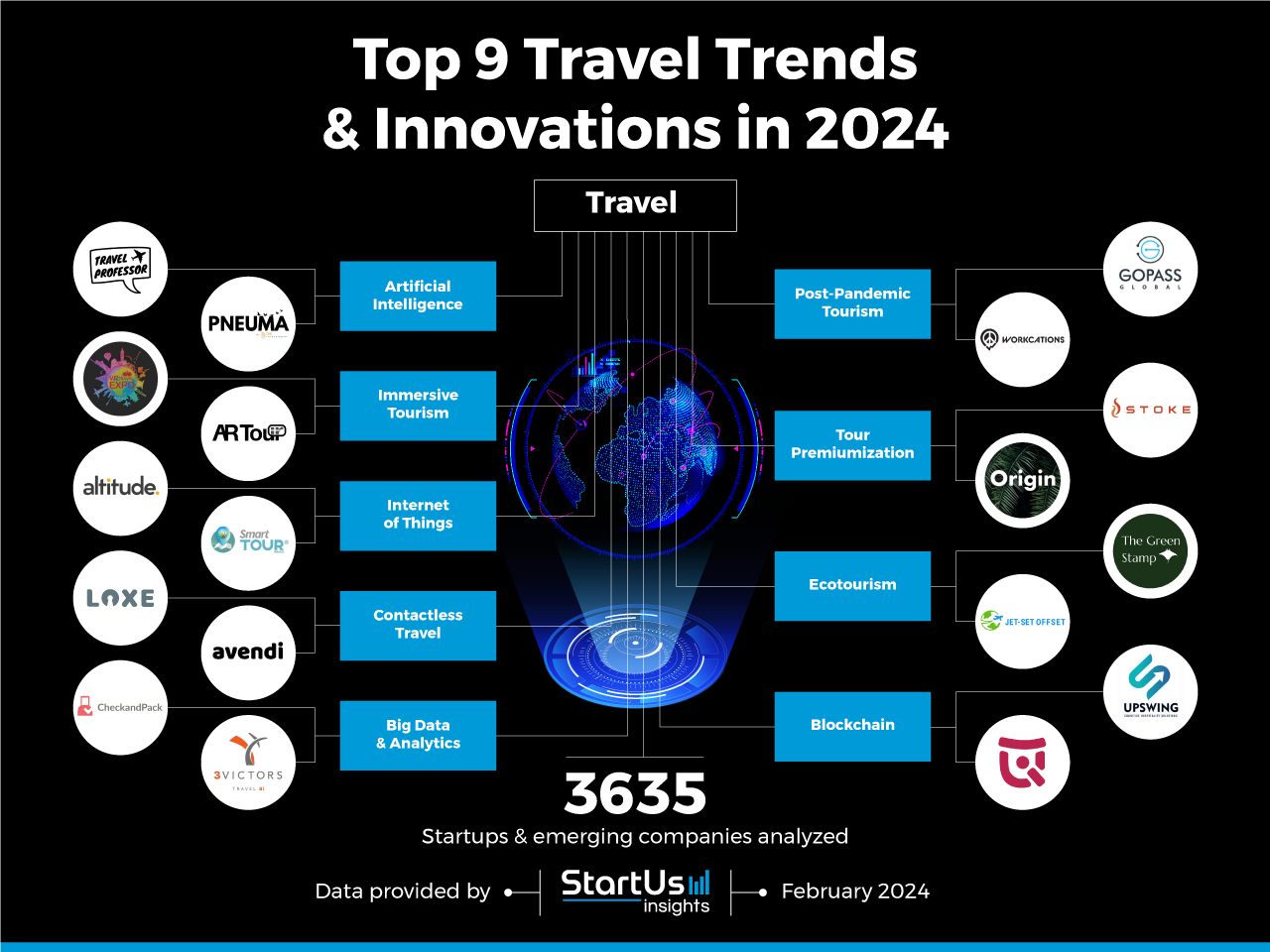
Click to download
Tree Map reveals the Impact of the Top 9 Travel Trends
Based on the Travel Innovation Map, the Tree Map below illustrates the impact of the Top 9 Travel Industry Trends in 2024. Startups and scaleups are enabling contactless travel using technologies like biometrics, radio-frequency identification (RFID), and near-field communication (NFC). This is due to increasing health and hygiene concerns post the pandemic. The use of AI in tourism ensures hassle-free trip planning while AR and VR allow tourists to virtually visit various locations and excursions. IoT increases visibility into tourism industry operations and allows passengers to track their luggage more efficiently. Further, the demand for personalized and luxurious travel is rising. Several startups enable recreational space travel as well as offer sustainable travel options to passengers.
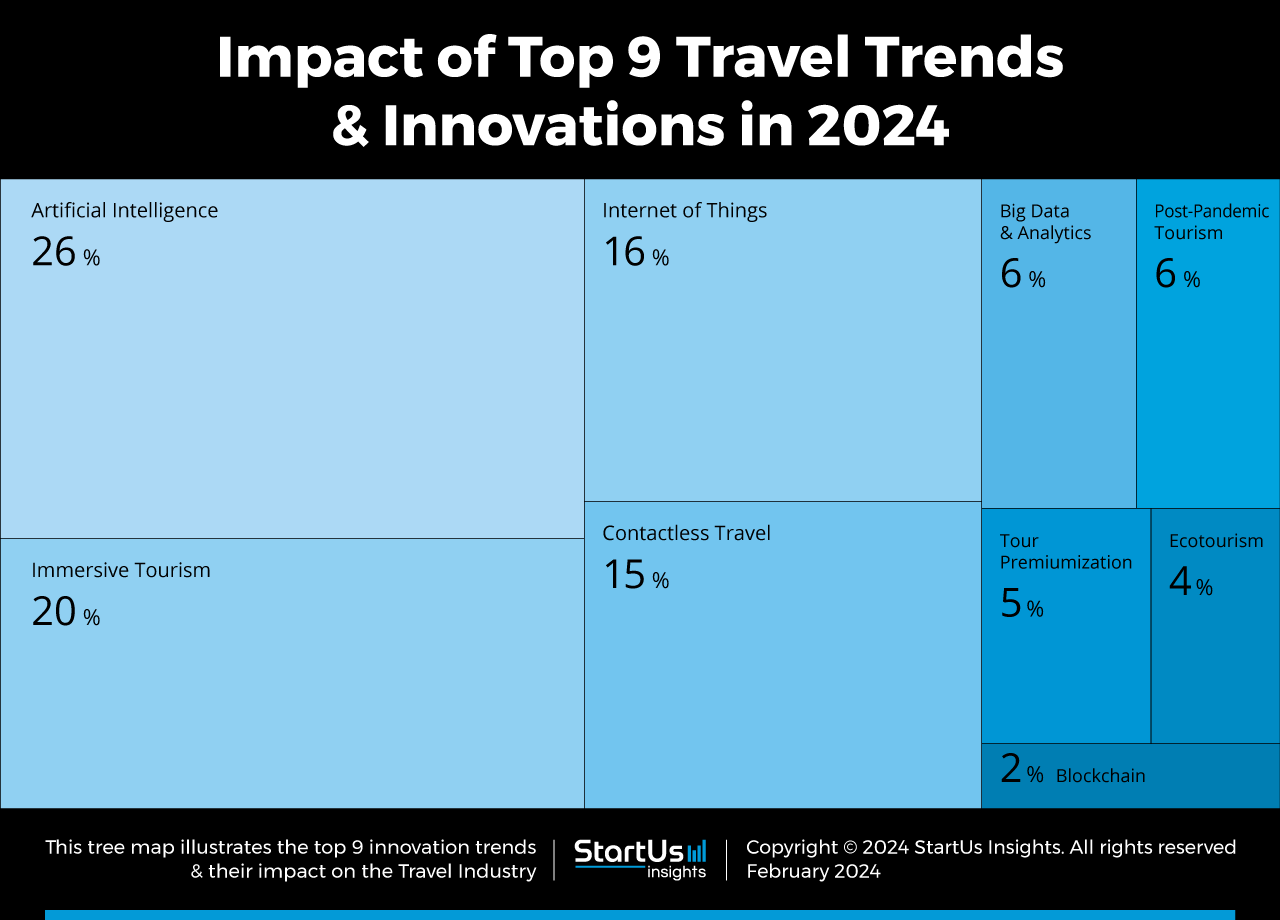
Global Startup Heat Map covers 3 635 Travel Startups & Scaleups
The Global Startup Heat Map below highlights the global distribution of the 3 635 exemplary startups & scaleups that we analyzed for this research. Created through the StartUs Insights Discovery Platform, the Heat Map reveals that the US, Europe, and India see the most activity.
Below, you get to meet 18 out of these 3 635 promising startups & scaleups as well as the solutions they develop. These 18 startups are hand-picked based on criteria such as founding year, location, funding raised, and more. Depending on your specific needs, your top picks might look entirely different.
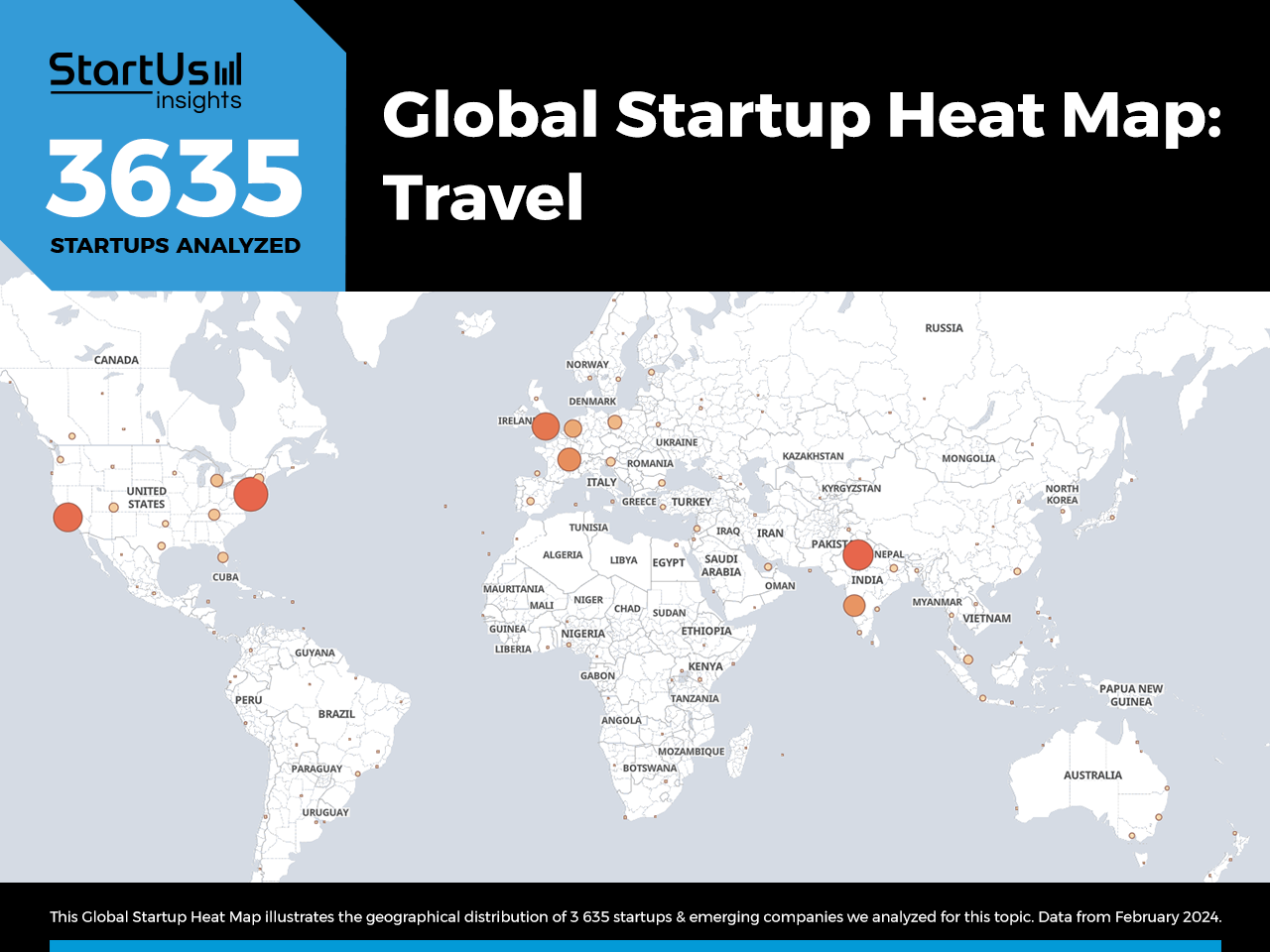
Interested in exploring all 3500+ travel startups & scaleups?
Top 9 Travel Trends in 2024
1. artificial intelligence.
Hotels employ intelligent chatbots, powered by AI, to provide quick and personalized responses to traveler inquiries. These chatbots simplify the booking process and gather customer reviews, aiding potential travelers in making informed decisions. Moreover, AI-based robots enhance the customer experience by automating hotel disinfection and delivering room service.
At airports, these robots guide travelers and assist with luggage handling. Facial recognition technology, driven by AI, expedites identity verification at airports, enhancing security and offering a swift alternative to traditional methods. Startups are developing AI-powered trip planning solutions, optimizing journeys, and personalizing travel experiences.
Travel Professor develops a Travel Chatbot
UK-based startup Travel Professor offers an AI-enabled chatbot for travelers. The startup’s chat widget software monitors multiple flight deals and notifies users when their preferences match. It also provides travel destination recommendations and flight price alerts. This allows travelers to book economical flights and have a budget-friendly tourism experience.
Pneuma Travel facilitates Travel Planning
US startup Pneuma Travel develops a voice-assisted digital agent, Sarah , to streamline the process of travel planning. This assistant, powered by AI, excels in arranging flight and accommodation bookings and assists travelers in discovering a variety of activities. Sarah , available round the clock, provides continuous support for all travel-related inquiries.
Moreover, Sarah customizes travel options according to individual preferences and budgetary constraints. The agent further enhances the travel experience by providing insights into local attractions in unfamiliar cities. Importantly, Sarah enables real-time modifications to travel plans, in compliance with specific airline policies, thereby minimizing waiting times for users.
2. Immersive Tourism
Immersive tourism caters to the growing demand for meaningful experiences among travelers, leveraging AR, VR, and mixed reality (MR). VR simulates original locations through a computer-generated environment, allowing tourists to virtually explore destinations. It provides travelers with a comprehensive 360-degree tour of points of interest.
AR enhances the travel experience with interactive elements such as navigation maps and ads. Travel companies employ AR and VR-based gamification to heighten tourist attractions. Moreover, these technologies enable hotels and resorts to present amenities and rooms in an engaging, interactive manner.
VR Travel Expo offers VR-based Travel Plans
US startup VR Travel Expo develops a VR travel application to transform the way people research and book travel. The application enables users to plan their vacations more efficiently. It provides an engaging platform for users to explore and expand their knowledge of the world. Moreover, it employs 3D geospatial technology that creates real-time digital twins of the world. This further enhances the travel planning experience.
AR Tour makes AR Glasses
Italian startup AR Tour offers AR-powered tours. The startup’s AR glasses superimpose reconstructed images of archaeological ruins to show how the site originally was. Its tour informs the tourists about the site’s history and significance via an audio-visual package. Moreover, the startup designs lightweight AR glasses to prevent motion sickness among tourists, improving convenience.
3. Internet of Things
IoT generates ample data that tourism companies leverage to personalize services in their subsequent visits. Hotels use IoT sensors to enable smart rooms that automate room lighting, temperature, and ambiance control, enhancing guest comfort. These sensors adjust appliances in vacant rooms, conserving energy and reducing the building’s carbon footprint.
Startups harness IoT to deliver location-specific information to customers, including real-time luggage tracking via IoT tags, minimizing lost items. Airlines also incorporate IoT-based solutions into seats, monitoring passenger temperature and heart rate for proactive health management.
Altitude enables Smart Hotels
New Zealand-based startup Altitude creates an IoT-based hotel software and hardware to develop smart hotels. The startup makes self-service kiosks to automate reservations, room up-gradation, payments, as well as check-in and check-out. Its hotel management platform further enables contactless engagement with guests. Additionally, Altitude’s mobile keys allow guests to open doors using mobile phones, providing convenience and saving time for travelers.
Smart Tour provides Smart Itineraries
Brazilian startup Smart Tour offers smart itineraries using IoT and quick response (QR) codes. The startup recommends travel routes and destinations based on the user’s preference in real-time. This facilitates a seamless experience for travelers. Besides, the user-generated data enables tourism managers to better understand consumer behavior and indulge in proximity marketing. The startup also offers a contact tracing solution to monitor COVID-19 infected travelers and ensure public safety.
4. Contactless Travel
Travelers benefit from contactless recognition technologies like retina scanning, which replace traditional travel documents, speeding up passenger identification and reducing airport queues. QR codes offered by travel companies allow tourists to access relevant information on their mobile devices, enhancing engagement.
Hotels have introduced contactless self-check-ins, enabling visitors to arrange services before arrival. Additionally, contactless payment modes are available in hotels and restaurants for swift and secure transactions. Moreover, wearable devices are transforming the travel experience by providing real-time notifications and touch-free access to services and information.
Loxe designs Smart Hotel Keys
US-based startup Loxe makes smart mobile keys for hotels. The startup’s smartphone app replaces key cards with contactless mobile keys that allow users to unlock doors using smartphones. It also reduces operational costs incurred in the manufacturing of conventional keys or plastic cards. Moreover, the startup designs a Bluetooth retrofit module that converts normal door locks into mobile-ready door locks. This allows hotel owners to easily convert their existing locks into smart ones without additional expenses while improving guest safety and convenience.
Avendi provides Contactless Payment
Singaporean startup Avendi offers contactless and cashless payments for travelers. The startup allows tourists to accumulate expenses throughout their trip and pay at the end of the journey. Avendi’s app utilizes QR codes to add all the billed expenses and shown through its dashboard. The user settles the tab amount in the preferred currency, preventing the inconvenience of cash withdrawal or credit card payments.
5. Big Data & Analytics
Big data empowers travel companies with customer trends for strategic marketing. Analyzing traveler behavior, they offer tailored recommendations for hotel bookings, cab hires, flight reservations, and ticket purchases.
Predicting future demand is another advantage of big data and analytics, helping hotels and airlines identify peak periods to optimize revenue. Advanced analysis of transactional data aids in detecting cyber fraud, and safeguarding sensitive customer information such as credit card details and biometric data.
CheckandPack creates a Travel Platform
Dutch startup CheckandPack offers a big data travel platform. It runs marketing campaigns to gather traveler data and understand tourism trends. Based on these insights, the platform enables businesses to approach travelers with a customized appeal. It also provides travelers with holiday planning.
3Victors provides Travel Data Analytics
US-based startup 3Victors offers travel data analytics. The startup’s product, PriceEye Suite , proactively monitors the prices of numerous airlines to provide insights into competitor prices. It creates a dashboard to display travelers’ location of interest, allowing travel airlines to better manage their revenue and pricing strategy.

6. Post-Pandemic Tourism
Post-pandemic tourism focuses on safe, sustainable, and flexible travel options, responding to evolving traveler preferences and health guidelines. Enhanced health and safety protocols, including regular sanitization and contactless services, become standard in airlines and hotels, ensuring traveler confidence.
Destinations and operators emphasize outdoor and less crowded experiences, catering to a heightened demand for nature-based and wellness travel. Flexible booking policies and trip insurance gain prominence, offering peace of mind amid uncertainties. Sustainable travel gains traction, with tourists and businesses prioritizing environmental impact and community well-being.
GOPASS Global enables Pre-travel Risk Management
Singaporean startup GOPASS Global provides a travel risk analytics platform against COVID-19. It analyzes the biosecurity risk elements involved in a trip, such as border restrictions, quarantine requirements, airport type, and airline transit points or seating in real-time. This allows travelers to assess risk factors and plan their trips accordingly.
Moreover, the startup creates world maps displaying information regarding COVID-prone areas, testing areas, and vaccine coverage. This provides travelers with a preview of the current situation, allowing them to ensure safety during business and leisure travel.
Workcations enables Work from Anywhere
Indian startup Workcations provides properties at tourist destinations for remote-working individuals. It offers amenities like internet connectivity, food, and a quiet ambiance, allowing tourists to work in a peaceful environment without hindrance. This increases employee productivity, motivation, and retention.
7. Tour Premiumization
Hyper-personalization in travel experiences is on the rise, with tourists eager to immerse themselves in diverse cultures. Luxury travelers enjoy tailored experiences and intuitive services through tour premiumization. Health and wellness packages offered by travel startups help tourists unwind.
These retreats enhance health and offer detoxifying food options. Space tourism is another exciting development, offering leisure or research trips to space. Lastly, travel startups are fostering customer loyalty and building strong relationships through membership or subscription models.
STOKE provides Space Tour
US-based startup STOKE facilitates space travel using everyday-operable rockets. The startup’s rockets are reusable and deliver satellites to any desired orbit. This enables on-demand access to space, paving way for space tours for exploration, recreation, and research. The startup also emphasizes the economical and rapid development of its hardware for feasible spacecraft launches, advancing space tourism.
Origin offers Travel Personalization
Dutch startup Origin provides premium travel personalization to tourists. The startup utilizes machine learning and travel curators to plan creative vacations. It also arranges flights and accommodation for travelers. Further, the startup measures the carbon output of itineraries and offers sustainable tourism options.
8. Ecotourism
Traveling responsibly minimizes tourism’s environmental impact and supports local communities’ well-being. Ecotourists strive to reduce their carbon footprint during their journeys. Startups contribute by developing sustainable transport, ecolodges, and solar-powered resorts.
Airline passengers have the option to offset carbon emissions during flight bookings. Local tourism stimulates small businesses economically and creates job opportunities. It also emphasizes minimum littering, which lowers pollution and the time spent on cleanups.
Jet-Set Offset simplifies Flight Carbon Offset
US-based startup Jet-Set Offset creates a carbon-offsetting platform for air travel. The startup partners with non-profit organizations working against climate change and connects them with travelers. Each time travelers book flight tickets via the startup’s platform, Jet-Set Offset contributes a certain amount per mile for their journey to environmental organizations. This way, the passenger’s journey promotes mileage-based donations to offset carbon emissions.
The Green Stamp facilitates Ethical Wildlife Tour
Dutch startup The Green Stamp provides a platform to book ethical wildlife tours. It curates tours based on the tourists’ inclinations toward certain locations or wildlife. Exploration of these projects allows travelers to indirectly contribute to their cause as these wildlife projects donate to the welfare of local communities and the environment.
9. Blockchain
Blockchain provides the travel industry with operational transparency and security. Traceable payments, particularly for international travel, are a key application, that fosters trust among parties involved in transactions.
Automation and enforcement of agreements in travel insurance and supplier contracts are achieved through smart contracts. This strengthens reliability and cuts administrative costs. Travel firms establish customer loyalty programs where points are exchanged for cryptocurrency. Lastly, blockchain increases data storage security, reducing the risk of information leaks.
Upswing facilitates Guest Profiling
Indian startup Upswing creates AURA , a blockchain-powered platform for guest profiling. It provides a holistic view of guests, their preferences, and purchase patterns. The platform associates a score with each guest and suggests improvements in their service. This facilitates hotels to provide a personalized experience to their guests and, in turn, increase sales.
UIQ Travel develops a Solo Traveling App
US-based startup UIQ Travel develops a blockchain-based app to connect solo travelers. It discovers people with shared interests and suggests tours or attractions. Such hyper-personalized recommendations assist in experience discovery and also increase traveler engagement.
Discover all Travel Trends, Technologies & Startups
Tourism, although severely impacted by the pandemic, now continues to rapidly grow across the globe. Post-pandemic trends indicate an increasing emphasis on hygiene and safety during travel. The industry is witnessing the widespread adoption of disruptive technologies like AI, XR, IoT, and blockchain. The travel industry utilizes big data to understand traveler trends for targeted marketing. The transition to ecotourism is accelerating as businesses integrate zero-emission transit and carbon offset programs to reduce their carbon footprint.
The Travel Trends & Startups outlined in this report only scratch the surface of trends that we identified during our data-driven innovation and startup scouting process. Among others, personalization, decarbonization, and travel safety will transform the sector as we know it today. Identifying new opportunities and emerging technologies to implement into your business goes a long way in gaining a competitive advantage. Get in touch to easily and exhaustively scout startups, technologies & trends that matter to you!
Your Name Business Email Company
Get our free newsletter on technology and startups.
Protected by reCAPTCHA and the Google Privacy Policy and Terms of Service apply.
Discover our Free Travel Report 21 pages
Get free updates on global startups, technologies & trends, join 25k subscribers.
Business Email
Book a call today!

Travel 21 pages report
Mobility 22 pages report, railway 22 pages report, cleantech 20 pages report.
Leverage our unparalleled data advantage to quickly and easily find hidden gems among 4.7M+ startups, scaleups. Access the world's most comprehensive innovation intelligence and stay ahead with AI-powered precision.
Get in touch
Your Name Business Email Company How can we support you? (optional)

Protected by reCAPTCHA and the Google Privacy Policy and Terms of Service apply.
- Hospitality Industry
INDUSTRY REPORT: Hospitality Innovation Strategy in Practice

April 17, 2019 •
6 min reading
The Hospitality Innovation Industry Report , authored by EHL Associate Professor Dr. Carlos Martin-Rios , is based around a comprehensive model reviewing combinations of technological and non-technological innovations and analyzes how different innovation strategies contribute to generating competitive advantages for hospitality businesses.
Dr. Rios has been tracking hospitality innovation for the past several years, surveying hundreds of managers and interviewing more than 50 executives and thought-leaders to produce this report.
Hospitality innovation management is one of the most salient topics in international hospitality, tourism and travel management. For many, innovation is equated with technology, and only scientists and engineers bring innovation to life. Yet, it can occur in many avenues that have little or nothing to do with technology or science.
Identifying the role of various forms of innovation and their impact on innovation returns and firm performance, provides valuable decision-making information for hotel managers. We rounded-up key takeaways from the report.

Technological innovation: all about products, services and processes
Nowadays most service innovations in hotels come from technological innovations. It is a crucial driver of growth, an effective way to neutralize digital disruption from OTAs and sharing economy firms, and an effective tool in attracting younger generations.
Technology innovation
In our study, close to 72% of executives reported to have implemented a considerable proportion of innovations in the technology category ; yet taking a closer look at the use of online technology, there are significant differences on how hotels, OTAs and AirBnBs interact with their guests before, during and after their stay and provide personalized service throughout.
Top executives and senior managers agree on the need to strengthen the industry’s ability to continuously adapt and innovate by facilitating investment in new technologies and continuously adapting to new technological capabilities. Despite the importance of technology advancement, these firms do not obtain significantly higher results in overall customer retention and average bed occupancy rate. Investment in new technologies should be strengthened through a combination of several forms of innovation.
Service innovation
Additionally, one of the keys to profitability in new service development is launching unique, superior services with a compelling value proposition. This trend is largely tapped into by successful hospitality firms as service innovation is prominent among successful hospitality firms. As recent research suggests, the nature of services and the pace of change have shifted dramatically in recent years, and mastering the traditional aspects of service delivery is no longer enough ( McKinsey, 2015 ).
Process innovation
Oftentimes, innovation in the hotel industry is not so much about new services, but really all about processes . It has been a while since hotels modernized their processes and optimized their operations by standardizing them. For long, most hotel practices have revolved around traditional P&L processes. Today, new processes bring together consumer experience, e-commerce, big data and digital transformation, and revenue growth analytics.
Non-technological innovation: a soft innovation practice in organizational, management, marketing and business model innovation
Management innovation.
While manufacturing firms gave birth to several managerial innovations ( TQM , MBO or agile management ), some of the latest management trends have emerged simultaneously in production and service environments, including hospitality. For example, agile management principles and techniques (or Scrum , Lean , and Kanban ) or collaborative user-oriented and supplier relationships and innovations.
Innovations in management play an important role for hospitality businesses. Not only from an outcome perspective but to develop, implement and monitor the progress of distinctive strategies boosting competitiveness.
Organizational behavior
Hospitality is a notoriously labor intensive activity. So from an organizational behavior standpoint, effective management is a vital component for higher performance. Although about 37% of hospitality firms report high levels of organizational innovation, the report shows that organizational practices of hospitality businesses - i.e. the adoption of new ways of organizing work processes, establishing alternative ways of managing employees and fostering internal leadership - need to be better articulated altogether. Indeed, there is a significant relationship between pursuing organizational solutions and managerial innovations and results suggest a strong association between organizational innovation, business model innovation and overall organizational effectiveness of a firm.
Marketing innovation
Close to 40% of all firms have heavily invested in their marketing innovation strategy. Marketing innovation allows hospitality businesses to harness the power of customer satisfaction and many hotels have made great efforts to build brand loyalty through various marketing innovations, including creating online brand communities, new loyalty programs, or social media analytics. These innovations do not work in isolation however, as marketing innovations have no direct significant economic implications for hotels.
Need more resources on the travel, tourism and hospitality industry?
Hospitality Industry - All Your Questions Answered
Business model innovation
Business model can be defined as the firm’s design or architecture of the value creation, delivery, and capture mechanisms it employs. While the next generation of game changers is already here - Internet of Things (IoT), Blockchain, 3-D printing, Artificial Intelligence (AI) - are hotels ready to challenge traditional thinking and invest in new business solutions?
As a matter of fact, only 19% of the surveyed companies pursue a medium intensive innovation strategy regarding their formulation of a business model . Yet, those firms actively innovating their business offering are also the companies with the most complex innovation strategy and the highest innovation intensity. There is a strong positive relationship between business model innovation and all performance indicators, with the exception of average bed occupancy rate, as seasonal fluctuations and external socio-economic factors have significant economic implications for hotels.

What's next: innovation trends in hospitality
Although sustainability and open innovation are not part of the innovation strategy of many hotel firms, our results illustrate how certain hospitality firms are engaging in these novel forms of redesigning the consumer experience and developing broad networks of relationships to generate innovation returns and firm performance.
Sustainability innovation
Sustainable innovations is more than a PR stunt, it can’t be mere corporate window-dressing. The hospitality industry is a major driver of economic development and has a major impact on several facets of sustainable development (SD). A strong commitment to SD by adopting sustainable practices has the potential to be beneficial for the hotel industry. Although some 80% of firms in the study indicated that they were investing heavily in eco-innovation, examples of hotels fully committed to sustainable management do not abound (yet). For that reason, first movers like Six Senses already have some significant advantages.
External business relationship
From formal business relationships (alliances, R&D projects or consortiums) to informal cooperative relationships, hotels can benefit from the participation within multiple kinds of network relationships . A considerable proportion of executives consider that the implementation of new methods of organizing external relations with stakeholders have an important impact on their business performance. Engagement in the establishment of external relationships helps them obtain, combine and exchange critical knowledge, which is directly related to its economic activity and strategic business priorities.
Download the Hospitality Innovation Strategy in Practice industry report

Associate Professor at EHL
Keep reading
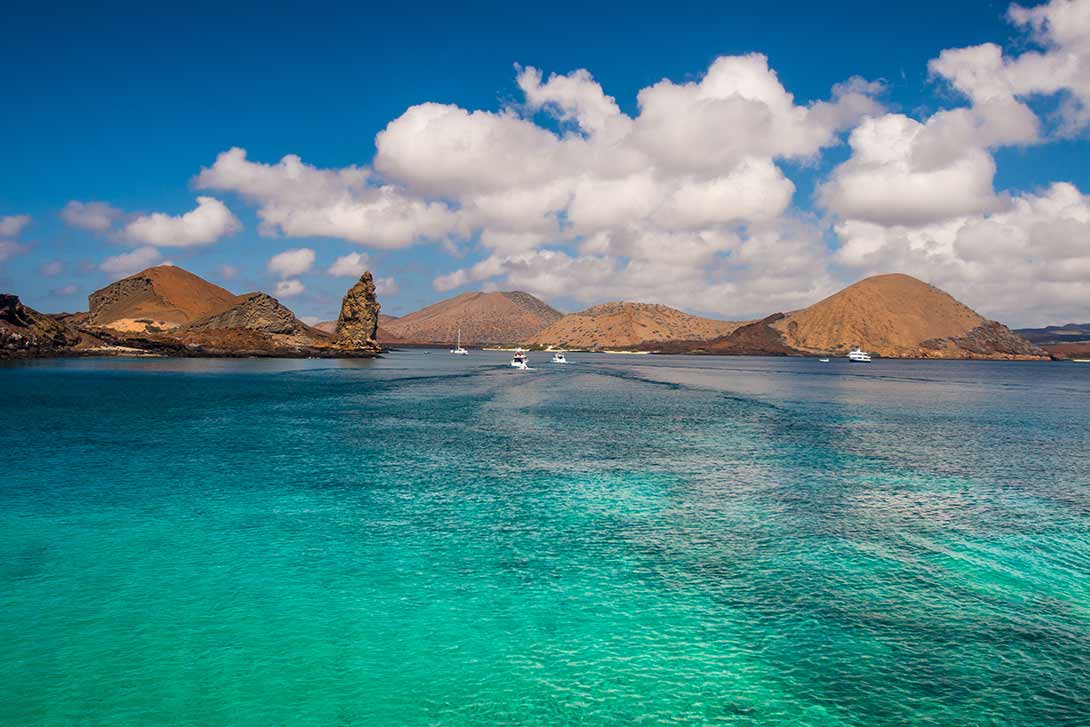
Understanding sustainability challenges in the Galapagos Islands
Jun 13, 2024

Human-centric hospitality: The key to thriving in the industry
Jun 12, 2024

Sexual harassment prevention in hospitality: An integrative framewwork
Jun 11, 2024
This is a title
This is a text
- Bachelor Degree in Hospitality
- Pre-University Courses
- Master’s Degrees & MBA Programs
- Executive Education
- Online Courses
- Swiss Professional Diplomas
- Culinary Certificates & Courses
- Fees & Scholarships
- Bachelor in Hospitality Admissions
- EHL Campus Lausanne
- EHL Campus (Singapore)
- EHL Campus Passugg
- Host an Event at EHL
- Contact our program advisors
- Join our Open Days
- Meet EHL Representatives Worldwide
- Chat with our students
- Why Study Hospitality?
- Careers in Hospitality
- Awards & Rankings
- EHL Network of Excellence
- Career Development Resources
- EHL Hospitality Business School
- Route de Berne 301 1000 Lausanne 25 Switzerland
- Accreditations & Memberships
- Privacy Policy
- Legal Terms
© 2024 EHL Holding SA, Switzerland. All rights reserved.
Official websites use .gov A .gov website belongs to an official government organization in the United States.
Secure .gov websites use HTTPS A lock ( A locked padlock ) or https:// means you’ve safely connected to the .gov website. Share sensitive information only on official, secure websites.
- Search ITA Search
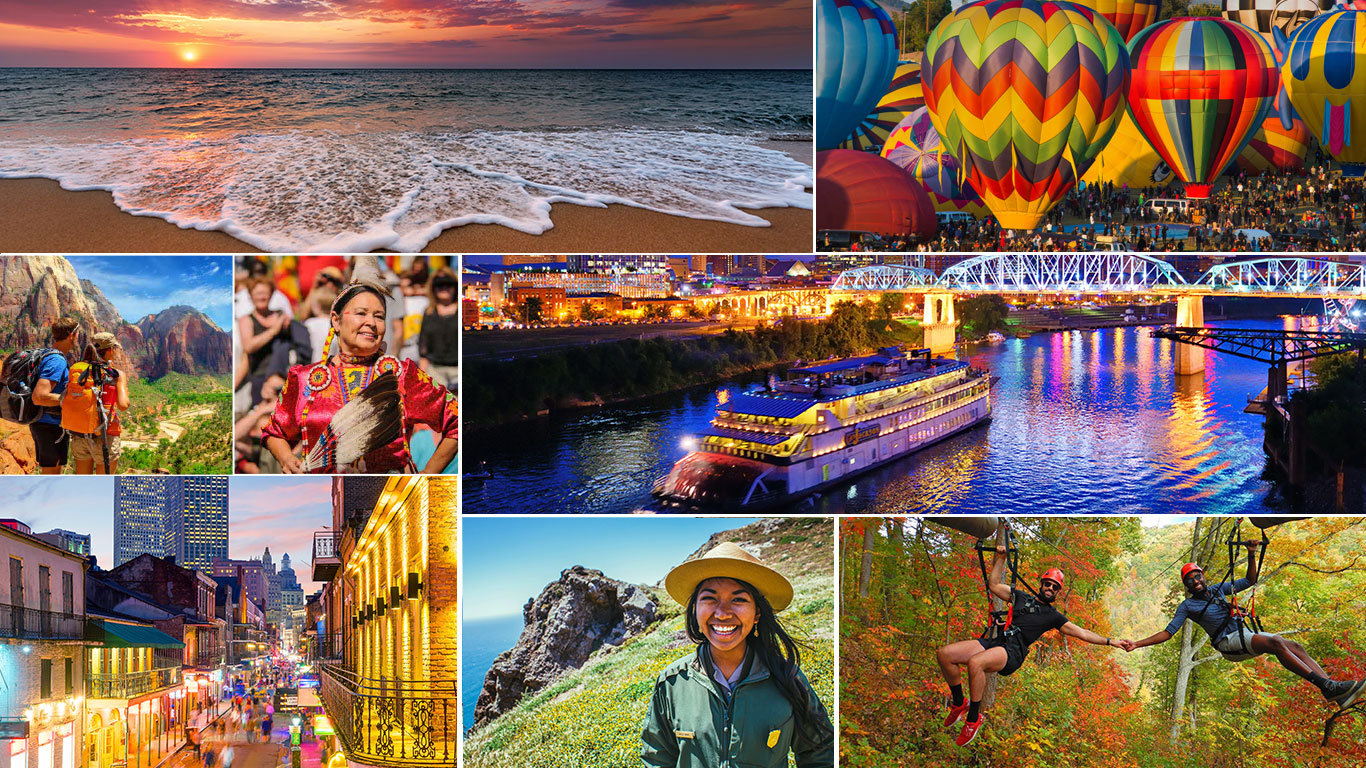
Discover the National Travel and Tourism Strategy, it promotes US destinations, fosters sustainable tourism, ensures diverse experiences, and reduces travel barriers.

- Tourism strategy
- Towards Tourism 2032
Tourism Technology and Innovation Roadmap
Towards tourism 2032: new ways of working.
The Tourism Technology and Innovation Roadmap supports more tourism businesses to adopt technologies and be more innovative in their tourism experience, service delivery and business sustainability.
By 2032, Queensland will have a high-functioning tourism network operating as an effective partnership model built on evolved technology strategies that harness:
- partnerships.
Together, these will enhance service delivery and inform decision-making while applying a consumer-centric approach to further improve Queensland’s competitive advantage.
Tourism Innovation Forum: Advancing Queensland’s Potential
Join us on Thursday 25 July 2024 for the inaugural Tourism Innovation Forum: Advancing Queensland’s Potential event.
Held at the Brisbane Convention and Exhibition Centre, this free, future-focused event will showcase tech wonderment, best practices, and new ways of working. Tourism operators will also have the opportunity to connect with innovators and the latest technology in the tourism industry.
Find out more and register .
Queensland tourism industry innovation challenge event
Held on Tuesday 14 May 2024, the Queensland tourism industry innovation challenge event delivered innovative solutions to two different challenges experienced by the Queensland tourism industry:
1. How can we enhance experiences at any stage/s of the travel consumer journey? 2. How can we unlock workforce capabilities for Queensland’s tourism sector?
After careful deliberation, two proposals stood out: Localis and Cinefly. Each earned prestigious grant funding of up to $100,000 jointly funded by the Department of Tourism and Sport and the Private Sector Pathways Program facilitated by Advance Queensland to bring their visionary projects to life.
Read more about Localis and Cinefly's innovative AI-driven platforms .
Reduce barriers and grow knowledge
The Tourism Technology and Innovation Roadmap aims to help tourism businesses adopt technology and innovative practices by reducing barriers and increasing knowledge.
Barriers include:
- Lack of understanding and/or experience – in available options or the questions to consider when choosing fit-for-purpose solutions. Lack of understanding of the benefits / return on investment.
- Confidence and risk aversion – ‘wait and see' approach. Concerns with potential business impacts by getting it ‘wrong’ (cost and time)
- Financial limitations – implementation costs are often high. Limited financial capacity to direct to innovation.
- Resource impacts - learning and development requirements for staff. Training on new systems may impact service delivery.
- Capacity and business pressures – no capacity to plan for innovation. Owners focussed on working in the business, not on the business. Integration – older ‘legacy’ systems in place may be incompatible with newer technologies.
How we plan to drive Queensland's tourism industry
Connect tourism with innovation.
Build tourism business capability
Attract investment in new tourism technology
1. Develop and support a tourism innovation and technology ecosystem that:
- connects the tourism industry with innovators
- enables the sharing of innovation experiences and learnings and provides opportunities for collaboration on innovation activities
- focuses on a ‘customer/visitor first’ approach to tourism
- boosts Queensland’s innovation capabilities to meet changing visitor needs.
2. Enable ecosystem mechanisms. For example:
- Meet the change makers
- Connect RTO’s with innovation hubs
- Establish monthly meetups
- Annual tourism tech event
3. Identify and promote connectivity solutions. For example:
- Innovation hubs
- Demonstration site
- Working spaces
4. Showcase innovative Queensland business solutions at key events such as:
- Tropical Innovation Festival
- Forward Fest
- Something Fest
- DestinationQ
Build tourism businesses capability
1. Undertake business capability mapping to:
- Identify and inform the tourism industry of existing innovation and technology resources and upskilling programs.
- Identify gaps in existing resources in the context of building tourism and events businesses' understanding and capabilities in innovation and technology.
2. Grow tourism businesses rates of technology adoption and adaptation through:
- micro-credentialing for tourism businesses in partnership with TAFE Qld, Qld Future Skills Partnership
- initiatives delivered through the Queensland Digital Strategy.
3. Support the development of immersive and transformational experiences and marketing through tech wonderment to which provides consumers with more compelling visitor experiences and drives conversion.
1. Facilitate transferable technology from other industries to tourism innovation and experiences.
2. Educate small tourism operators on:
- investment options for product and experience development
- the return on investment and other benefits of enhancing their business practices and experiences through technology solutions.
Last updated: 17 Jun 2024
Language selection
- Français fr
Government of Canada releases new Federal Tourism Growth Strategy
From: Innovation, Science and Economic Development Canada
News release
New strategy will foster growth and competitiveness of the tourism industry
July 4, 2023 – Niagara, Ontario
Tourism powers the Canadian economy, creating good jobs in every region of the country, from rural and remote communities to the largest cities. Tourism is also highly inclusive. Compared to other sectors, it employs a higher proportion of women, youth and newcomers. Canada has something for everyone: breathtaking outdoor adventures, vibrant cities, unique Indigenous tourism experiences and so much more. With the renewed demand for travel, there is now a once-in-a-generation opportunity for Canada’s visitor economy to push past reviving all the way to thriving and successfully compete on the global stage. The Government of Canada is focused on seizing this opportunity to help the tourism industry reach new heights for generations to come.
Today, the Honourable Randy Boissonnault, Minister of Tourism and Associate Minister of Finance, unveiled the new Federal Tourism Growth Strategy , entitled Canada 365: Welcoming the world. Every day. He was accompanied by Vance Badawey, Parliamentary Secretary to the Minister of Indigenous Services and Member of Parliament for Niagara Centre; Chris Bittle, Parliamentary Secretary to the Minister of Canadian Heritage and Member of Parliament for St. Catharines; Marsha Walden, President and CEO of Destination Canada; Beth Potter, President and CEO of the Tourism Industry Association of Canada; Keith Henry, President and CEO of the Indigenous Tourism Association of Canada; and Susie Grynol, President and CEO of the Hotel Association of Canada.
The new strategy will unleash the full potential of Canadian tourism and cement Canada as a top global destination through the following five priorities:
- Investing in Canada’s tourism assets
- Embracing recreation and the great outdoors
- Partnering to grow Indigenous tourism
- Attracting more international events
- Improving coordination through a federal ministerial council
The strategy is informed by months of consultations with, among others, tourism businesses, industry associations, other orders of government, Indigenous partners and destination marketing organizations. Their valuable insight into the challenges and opportunities of the Canadian tourism sector have shaped the strategy and helped set the stage for the long-term growth of Canada’s visitor economy.
“Now is the time to come together and combine forces—across all orders of government and throughout the industry—to power the economic engine that is tourism. With the new Federal Tourism Growth Strategy, we will build on our strengths and propel the sector to new heights. Canada has what the world wants, and we look forward to welcoming visitors, 365 days a year.” – The Honourable Randy Boissonnault, Minister of Tourism and Associate Minister of Finance
“We are Niagara—tourism is in our blood. We understand the importance of this industry to the people of Niagara and to the employees, business owners and organizations that thrive because of our region’s natural gifts and its existence as a major North American destination for travellers from around the world. This new Federal Tourism Growth Strategy will help drive the success of our tourism sector and ensure it continues to contribute to the economic prosperity of Niagara for decades to come.” – Vance Badawey, Parliamentary Secretary to the Minister of Indigenous Services and Member of Parliament for Niagara Centre
“Every year, our tourism sector brings people from around the world to our country and specifically to our region. We have a lot to offer, whether you have been to Canada a dozen times or are planning your first trip. This strategy demonstrates the strength of our sector and lays the foundation for its future success. With this Federal Tourism Growth Strategy, Niagara will continue to be ready to welcome the world, each and every day.” – Chris Bittle, Parliamentary Secretary to the Minister of Canadian Heritage and Member of Parliament for St. Catharines
“Today’s announcement caps more than a year of dialogue with key stakeholders on all facets of the tourism sector across this great country. TIAC welcomes the new Federal Tourism Growth Strategy and applauds the government’s recognition that tourism is a key driver of Canada’s economy, creating close to two million jobs in large and small communities and being highly inclusive. We embrace the opportunity to continue working, hand-in-hand, with the Minister of Tourism, other Cabinet ministers and federal officials on the strategic path toward full industry recovery, growth and sustainability.” – Beth Potter, President and CEO, Tourism Industry Association of Canada
“Indigenous tourism has enormous potential and is reconciliation in action. Today ITAC is delighted to see Indigenous tourism be a key pillar of the Federal Tourism Growth Strategy, and we support the growth of Indigenous tourism through coordinated investments from the Government of Canada that will help make Canada the global leader in Indigenous tourism by 2030.” – Keith Henry, President and CEO, Indigenous Tourism Association of Canada
“The Hotel Association of Canada enthusiastically welcomes today’s announcement. Investing in Canada’s assets and attracting more international events will support the hospitality industry, which will in turn sustain a thriving visitor economy.” – Susie Grynol, President and CEO, Hotel Association of Canada
“We welcome the launch of the new Federal Tourism Growth Strategy, which will help lay the foundations for our sector’s future growth, investment and competitiveness. Along with our industry partners from coast to coast to coast, we have worked together to make united recommendations on this strategy, and we look forward to working closely with the Minister as together we transform tourism to be more competitive, successful, and resilient.” – Marsha Walden, President and CEO, Destination Canada
“As a key component of our country’s tourism product, the restaurant industry is very pleased to see the launch of a new tourism strategy for Canada. Our industry is still in recovery mode following the pandemic, and this strategy will bring more visitors to our great country and in turn to our restaurants. We thank Minister Boissonnault for driving this strategy to completion.” – Kelly Higginson, President and CEO, Restaurants Canada.
Quick facts
Tourism is a key contributor to Canada’s economy. In 2022, the sector supported approximately 623,375 direct jobs and 1.9 million total jobs.
In 2022, tourism contributed nearly $38 billion to Canada’s GDP, generated close to $94 billion in revenue for businesses, and accounted for almost 13% of service exports.
In 2022, there were 218,041 businesses in the tourism sector.
In 2022, non-resident tourism spending rose by almost 321% compared to the previous year, recovering to over 70% of the 2019 peak of $28.6 billion.
Destination Canada forecasts that tourism spending will fully recover by 2024 and international visitation will fully recover by 2026.
In 2022, youth made up about one third (33.2%) of tourism workers, compared to the total economy average of 13.3%.
In 2022, immigrants made up 29.2% of the tourism labour force, slightly higher than the total economy average of 27.6%.
Associated links
- The new Federal Tourism Growth Strategy
- The Canadian tourism sector
Farrah-Lilia Kerkadi Press Secretary Office of the Minister of Tourism and Associate Minister of Finance 343-553-6203 [email protected]
Media Relations Innovation, Science and Economic Development Canada [email protected]
Stay connected
Find more services and information at Canada.ca/ISED .
Follow Innovation, Science and Economic Development Canada on LinkedIn .
Follow @cdntourism on social media: Twitter , Instagram .
Follow Canada Business on social media: Twitter , Facebook , Instagram .
Page details
Academia.edu no longer supports Internet Explorer.
To browse Academia.edu and the wider internet faster and more securely, please take a few seconds to upgrade your browser .
Enter the email address you signed up with and we'll email you a reset link.
- We're Hiring!
- Help Center

Innovation strategy in Tourism industry

2017, University of Stavanger, Norway
Focus: Nowadays, innovation research in tourism sector has catch the attention of academics and business players. In fact, over the decades, tourism has experienced continued growth and deepening diversification to become one of the fastest growing economic sectors in the world. This master thesis, is to study in detail the theory of innovation in tourism and, to develop innovation strategies for the tourism sector. This thesis is based on theoretical review about the concept of innovations in tourism industry to understand different types of innovations, the measurements and determinants of innovation. Although, innovation strategies and strategic innovation in tourism industry were the main focus of the study. Findings: The findings provide a practical contribution to academics and companies on how certain strategies can be implemented in the tourism sector, such internationalization, the use of new technologies and sustainability. Moreover, different tools of strategy management were also studied, along with the innovation systems and innovation management. Research limitations / implications: This paper is only limited to the theoretical part of innovation strategies in tourism industry. Performing an empirical study would be much more interesting, to learn more about how these different strategies are implemented. Furthermore, I have been focusing on all dimensions of strategies, and was unable to draw a practical conclusion but several valuables recommendations were provided. Originality – Value: This study has established a framework for the further study of innovation in tourism. Accordingly, research in the field of innovation systems and innovation management might be developed in several forms. Regarding the innovations strategies, these are certainly useful knowledge for both academics and managers.
Related Papers
Cagri Bulut
Innovation and creativity are issues that are commonly used from the perspective of the manufacturing industry, though they are as much needed in the services industries for effec-tive and efficient results. Innovations in general may be the profitable market introduction of new products and services, improved production techniques or processes or a better or more efficient way of applying marketing, communication and management strategies or a new way of implementing organizational applications. Service industry differs from the manu-facturing industry in many aspects like being intangible, no storage possibility, consumption and production at the same time and place, being highly perishable etc. but still innovation theories can also be used to describe changes in services and tourism industry. The study focuses on innovation applications in tourism industry by analyzing success-ful case studies. Innovation success factors were examined and common issues were found which are provi...
Intangible Capital
Federico Rodriguez Torres , Alejandro Delgado Cruz , Elva Esther Vargas Martínez
Purpose: This paper makes a literature review in order to analyze the current state of innovation in tourism companies and know the future research lines on the subject. Design/methodology: The study chose a content analysis, which purpose was to examine the scientific journal articles about tourism, business management and economic-administrative studies, considering ScienceDirect, Taylor & Francis, EBSCOHost and REDALYC databases. The procedure involves filtering papers based on criteria of relevance as addressing the issue and current facts (texts inscribed in the period 2008-2015). As a result 78 publications based on bibliographic content matrices were analyzed and classified according to their thematic profile. Moreover, a search for bases outside the above data was done, in order to know the situation of tourism companies in the Mexican context. Findings: The review shows that papers are concentrated in six broad categories: a) organizational innovation, b) innovation strategies, c) innovation in products and processes, d) technological innovation, e) knowledge management in innovation and f) innovation models. Most studies are given in the context of hotels and restaurants; showing that innovation in tourism companies is an emerging theme study that will strengthen the development and competitiveness of the sector itself. Originality/value: It represents an innovative contribution by providing information on how it has been addressed the issue of innovation in the context of tourism companies -restaurants and hotels-, besides provides an overview of research conducted in Mexico on the topic, being of interest to the companies and academic community.
Miroslava Medveďová
Decreasing number of visitors, decreasing number of overnight stays and decreasing sales are characteristics of the market environment in tourism destination in Europe (Tourism statistics from Eurostat 2015). It is now a prerequisite for success in tourism to offer new, unique products to help tourism destinations, as well as the individual providers of services, who should be able to differentiate themselves from the competition. Innovations represent a new idea or concept that is clearly creating new jobs, even in remote tourism resorts far from shopping centers. The goal of this paper is to define the categories of innovation including, process, marketing, institutional, management, product and service innovations, as well as the knowledge applied to examples of products, organizational and procedural innovations in tourism.
Tourism Management
Bénédicte Aldebert , Rani J. Dang
Sharfina Fauziyah W
Forum Scientiae Oeconomia
Klaus Weiermair
Interdisciplinary Description of Complex Systems
Tivadar Mahr
CORNEL PEPA
RELATED PAPERS
Mariusz Mazur
Shifu Careaga
Ameni BEN SIK ALI
Gohar Ayub Shah
EL CONSENTIMIENTO INFORMADO EN INVESTIGACIÓN
Viviana Lifschitz
Fumio Imazeki
ROMI SISWANTO
Cirugía Española (English Edition)
Luis Castañeda Gomez
Journal of Accounting, Auditing & Finance
Stephen Figlewski
Muhammad Hamayun
Fluid Phase Equilibria
Li-Jen Chen
Anais do Concurso de Teses e Dissertações da SBC (CTD-SBC)
Marcos Goncalves
RELATED TOPICS
- We're Hiring!
- Help Center
- Find new research papers in:
- Health Sciences
- Earth Sciences
- Cognitive Science
- Mathematics
- Computer Science
- Academia ©2024
UN Tourism | Bringing the world closer
- SUSTAINABLE DEVELOPMENT
- COMPETITIVENESS
- INNOVATION AND INVESTMENT
- ETHICS, CULTURE AND SOCIAL RESPONSIBILITY
- TECHNICAL COOPERATION
- UN TOURISM ACADEMY
share this content
- Share this article on facebook
- Share this article on twitter
- Share this article on linkedin
Innovation, Education and Investments
In order to anticipate, address and overcome the new challenges and trends of the Tourism sector, the World Tourism Organization is currently focusing on a strategy on Innovation, Education, Digital Transformation and investments.
Harnessing innovation and digital advances provides tourism with opportunities to improve inclusiveness, local community empowerment and efficient resource management, amongst other objectives within the wider sustainable development agenda
In general terms, with this strategy, UN Tourism aims to drive the digitalization of tourism and to create an Innovation and Entrepreneurship Ecosystem that will maximize the potential of the sector in terms of economic growth, job creation and sustainable development.
Action Plan
In order to achieve the above-mentioned objectives, UN Tourism will focus on 3 main lines of action alongside strategic projects, as below:
UN Tourism Innovation Network : As part of the Innovation, Digital Transformation and Investments Department´s mission of fostering synergies among key stakeholders and promoting the exchange of knowledge among actors and change-makers with the objective of contributing to the promotion of the United Nations Sustainable Development Goals, we aim to make innovation a key pillar of the sustainable development of tourism.
UN Tourism Tourism Startup Competitions
UN Tourism Innovation Challenges
The UN Tourism Innovation Hubs Network : will unify the leading innovation hubs worldwide into one Network dedicated to connecting and scaling up the innovation and entrepreneurship ecosystems of UN Tourism Member States by bringing together the leading tourism stakeholders, including governments, academia, corporations, SMEs and start-ups, investors (business and super business angels, venture capital, etc.) and supporting business partners (accelerators, incubators, etc.) in order to boost innovation and entrepreneurship. This Network would facilitate collaboration, inspiration and capacity building on how to scale and go global. Member States will actively be involved by launching innovation challenges.
- UN Tourism Tourism Tech Adventures: the first innovation forum dedicated to tourism that brings together all the actors of the ecosystem to boost innovation, entrepreneurship and especially, investment in Tourism. The Tourism Tech Adventures will include activities such as startup bootcamps, one-on-one networking sessions between startups, corporations and investors, hackathons and startup competitions. Furthermore, seminars on relevant topics will be provided for Tourism Ministers. These events can be adapted to global, regional, local and even vertical levels, like sport tourism.
- Innovation Trends and Guidelines: will help UN Tourism Member States to develop strategic and innovative tourism products by providing understanding of current social trends and customer needs.
UN Innovation Network
- UN Tourism is part of the UN Innovation Network
- UN Tourism is using the UN Innovation Toolkit
Education & Digital Transformation
Smart Destinations and capacity building : a focus on improving the sustainability, accessibility, governance and quality of destinations through the use of new technologies and innovations.
UN Tourism Tourism Online Academy
Bachelor of Science in International Sustainable Tourism
Tourism Education Guidelines
UN Tourism Toolkit for the Incorporation of Tourism as a Subject in High Schools
AHLEI Curriculum: Hospitality and Tourism Management
Cambridge Curriculum: Supporting the Education of Travel and Tourism
Investments
- Tourism Doing Business Investing: The series of Tourism Doing Business reports is a tool reference for investors that provides valuable information on countries' investment climate as well as emerging investment opportunities. The publications promote redesigning an investment framework where education, innovation, and sustainability are the fundamental pillars.
- UN Tourism Investment Guidelines Series : The multi-dimensional nature of the tourism sector, combined with the dynamics of the source of investment capital presents a complex picture for understanding and measuring tourism investments. At the same time, changing consumer behaviors and expectations, the advantage of technology, and the urgent need for greater sustainability challenge the current business models, and present new opportunities for investors interested in the tourism sector.
- Global FDI Greenfield Investment Trends in Tourism : For the third year in a row, the UN Tourism has partnered with the fDi intelligence from the Financial Times to develop a joint publication on Tourism Foreign Direct Investments (FDI) analyzing data on Greenfield investments trends.
- Green Investments for Sustainable Tourism : In order to continue with the collaboration between UN Tourism and IFC. It was decided to launch pilot phase in the following countries: India, Indonesia, Jamaica, Philippines, South Africa, Thailand, and Vietnam, with the view of expanding to several other countries in the next phase.
- UN Tourism Investment Fora & Events
Related links
- Innovation, Education and Investments 2018 - 2021
- What is innovation?
- Digital Transformation
- Bloomberg Harvard City Leadership Initiative, by Fernando Monge
- IDT Strategy

- Increase Online Bookings
17 Innovative Tourism Business Ideas and Trends for 2024

In This Article: Trends to Inspire Your Tours and Activities
Gig-Tripping, Bleisure, and Skip-Gen Travel: From eco-conscious adventures to immersive culinary experiences, what are some of the top travel business ideas likely to appeal to travelers in 2024? And how can tour businesses capitalize on them?
It’s that time of year again; when we take a deep dive into the research into travel and tourism trends for the year ahead so you don’t have to. As well as scouring the travel press, talking to our partners, customers and contacts, and racking our own brains here at Rezgo, we’ve picked highlights from several influential research reports into tourism business trends for 2024.
Even if you’re getting into the tour operator industry, there’s a lot of reasons to be optimistic. Read on to learn the tourism trends you can use to start your tour business in 2024.
Reasons to be cheerful about tourism in 2024

These findings were backed up by UNWTO’s latest Tourism Confidence Index survey of travel professionals. It found that “67% of tourism professionals indicating better or much better prospects for 2024 compared to 2023.”
According to the UNTWO, reasons to be optimistic in 2024 include:
- An uptick in the reopening of several source markets and destinations in Asia
- An increase in Chinese outbound and inbound tourism
- More travel to and around the Middle East and Africa through a unified tourist visa implemented by Gulf Cooperation Council (GCC) countries
- Strong outlook for travel to Europe, for example for the Paris Summer Olympics, and from the United States, backed by a strong US dollar
On the flip side, according to UNWTO findings, “Persisting inflation, high interest rates, volatile oil prices and disruptions to trade can continue to impact transport and accommodations costs in 2024.” In addition, if you have been having difficulties finding staff, you’re not alone. Many tourism businesses continue to face challenges filling vacancies to help them meet the steadily rising demand from travellers.
Overall though, 2024 promises an exciting array of tourism trends that cater to diverse interests and preferences. Let’s take a look at travel and tourism business ideas for 2024, with a focus on ideas for tours, events, activities and attractions that your travel business could use to attract new and existing customers alike.
Trending tourism business ideas for 2024
1. sustainable tourism and ecotours.
According to the UNWTO report, many travellers will consider “sustainable practices and adaptability” when making their travel plans in 2024. They are not only interested in booking with tour companies that do business in a sustainable way, but they also want to travel in an eco-friendly way, seek out eco-friendly places to stay and book activities and tours with a sustainability element. This is backed up by Arival’s “ The 2024 U.S. Tour Taker ,” which found that nature tours and other “ecotours” are in high demand from US travelers in particular.
Booking.com’s trends report for 2024 prompted the online travel marketplace to predict that ”the world of travel is poised for a sustainable makeover,” as travellers seek out eco-friendly places to stay and activities and locations with a sustainability element. TravelPulse reported that many travelers increasingly look to travel off season and seek out less well-known destinations to do their bit to try to decrease overtourism.
So-called “ecotours” let tourists enjoy a vacation while also learning about environmental and sustainability issues in a particular location. Some enable people to do something tangible to help, such as volunteering to plant trees or help to restore habitats. Many travelers these days also seek out “small footprint” or socially-responsible travel. This may not be an ecotour as such; it could just mean they favor tour companies that take steps to minimize the impact of their tours or incorporate a social responsibility element. Booking.com’s Sustainable Travel Report 2023 found that 76 percent of travelers want to travel more sustainably in 2024.
2. Train travel
From the “Flying Scotsman” to the “Orient Express,” there are few more romantic ways to travel than by train. However, train travel continues to overlap with other trends in our list, as it becomes more popular as a way to travel more sustainably by reducing car and air travel, traveling slower (unless we’re talking train travel in Japan) and for longer, as well as traveling to more countries on the same trip. Train travel as both a means to travel and see more of a destination continues to increase in popularity. Euromonitor International found that in 2024, “the fastest growing travel category worldwide is rail transport at 35.6 percent over 2023-2024.”
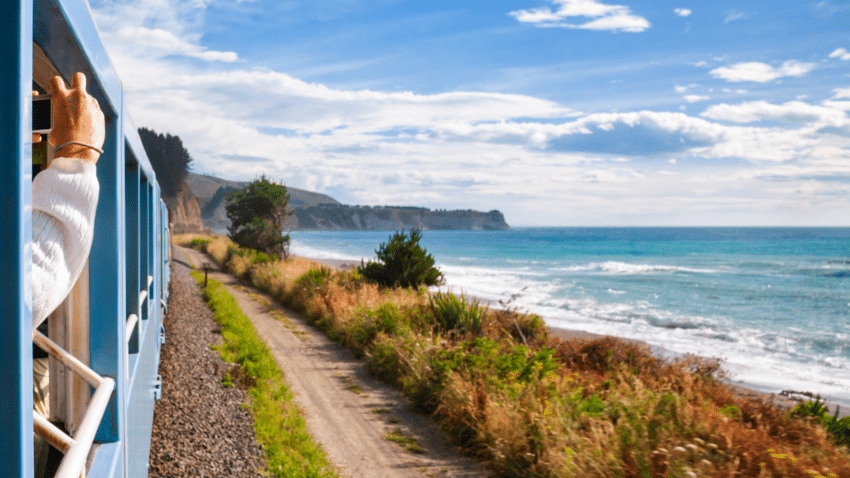
Train travel can also offer scenic views, comfortable travel with spacious seats, sleeping accommodations for longer or overnight trips, the opportunity to socialize with other travelers, and convenient access to city centers. Again overlapping with other trends, train travel also offers more immersive travel experiences and lets travelers see more of a country while mixing with locals. Many countries and rail companies, especially in Europe, offer passes that let travelers visit multiple places in one trip without leaving the ground.
3. Food and drink experiences

Many of the reports we looked at highlighted culinary experiences as a trend for 2024. After all, who doesn’t like a good meal or drinks with friends? Many travellers want to combine their love of food with their love of travel. Food tours allow travellers to savour the authentic flavours of a destination while discovering, and literally getting a taste for, its cultural heritage. Activities such as cooking classes let travelers enjoy an even more immersive culinary experience.
While winery tours have long been a favourite travel activity for wine lovers, an explosion of craft beer, vodka, gin and other drink producers provides a multitude of other opportunities for drink-related tours activities. They can cater as much to enthusiasts looking to indulge in the finer things in life, as true connoisseurs. Booking.com found that 78 percent of travellers want to experience new foods, and half go to the length of organizing trips around specific restaurants or dishes, including iconic dishes of particular destinations. And keep an eye on “wild-feasting”—a new trend where you not only eat locally-grown ingredients but forage for, and even cook, them in the wild.
4. Sports tourism
Sport is a passion for many people around the world, and travelers often like to combine their love of a particular sport or sports team with their passion for travel. In 2024, Europe hosts the Paris Summer Olympics and the soccer UEFA Euro 2024, while soccer lovers often travel to see their favourite team in England, Spain, Germany and the top European leagues. However, even smaller teams get a look in. The Netflix show Welcome to Wrexham has put the small Welsh town on the map after Hollywood stars Rob Mcelhenney and Ryan Reynolds bought the local soccer team.

As well as events like the Olympics, there are also annual events that attract global interest, such as the Super Bowl, the Tour de France and Formula One, which also has a hit TV show, Formula 1: Drive to Survive . A sporting, or other, event can provide a reason for people to visit a particular location, even if they don’t have tickets, to sample the atmosphere and explore the sights.
5. Tours and experiences with locals

Immersing oneself in the local culture is made possible through tours or experiences led by knowledgeable locals. These insiders offer unique insights, hidden gems, and authentic encounters that enhance the overall travel experience. They help meet a growing demand for more immersive experiences that take travelers inside a location and culture and deepen their understanding of it. Hilton’s 2024 Trends Report found that many travellers will prioritize experiences (85%), exploring the unknown, trying local food, and learning about the local culture.
Indigenous experiences are still a growing trend. Countries around the world, such as Canada, Australia and New Zealand, are making an increased effort to reverse past wrongs when it comes to treatment of Indigenous peoples, while also empowering Indigenous communities to take a lead in areas like travel and tourism.
6. Transformational trips
A buzz phrase you heard a lot of in 2023 was “transformational retreat,” and 2024 looks likely to continue the trend. Booking.com’s 2024 travel trends report prompted them to label 2024 as a year that reinforced that “travel isn’t just an escape, but a catalyst for experiencing our best lives.”

A transformational trip is a travel experience designed around a specific activity, personal goal, or mental or physical health need. They can include retreats that cater to people who want to undergo a significant personal or spiritual transformation, or at least get away from it all in order to return refreshed. Retreats and activities include meditation, yoga, therapy, workshops, and other experiential practices. Most promote self-awareness, personal growth, and positive change, typically taking place in a secluded and peaceful setting and led by experienced facilitators or coaches.
Wellness vacations have been a growing tourism business trend for some time, with demand accelerated by the pandemic. Tours that offer people the chance to pamper themselves and generally recalibrate are likely to be extremely popular for the foreseeable future.
7. Quiet travel
Not everyone is looking for a transformational outcome from their vacation; many simply want to unwind and enjoy some quality “me time.” Continuing the 2023 trend, many people still want to unplug and undertake a “digital detox.” They could be seeking respite from “doom scrolling” through social media and news feeds on their digital devices, or they just want a break from the glowing screens so prevalent in their day-to-day.

Trips that encourage travelers to leave their devices at home will be popular, whether to a wellness retreats that bans or discourages digital devices, or an out-of-the-way destination that makes electronic communication extremely difficult. As well as digital detoxing, an example of a trend that is still going strong is forest bathing. This involves becoming immersed in nature to enhance physical, mental, and emotional well-being. It can be as simple as going for a long walk through a forest, or sitting by a lake and taking in the sights, sounds, and smells of the natural surroundings. Research has shown that forest bathing can reduce stress and anxiety, improve mood, and even boost the immune system and reduce blood pressure and heart rate.
8. Skip-gen travel
Deloitte’s “2024 travel industry outlook” report found that the baby boomer generation is getting back into the swing of things when it comes to traveling. This could be a factor in the emergence of a trend towards “skip generation trips” or skip-gen travel. This is when grandparents take their grandkids on vacation as a way for these two generations to bond and create some memories. Boomers can have more disposable income and more time, and parents with kids that can travel in this way appreciate the chance to travel on their own or just enjoy a break at home. All-inclusive resorts and other places with lots of activities for different generations are popular skip generation trips.
9. Solo travel
Of course, not everyone has a posse to travel with or wants to travel with others. Solo travel continues to be very popular and has moved from a niche to a mainstream market. A Skyscanner report found that 40 per cent wanted to travel solo for mental health wellness reasons, while singles and divorcees ranked highly for being ready to take a solo trip. The report concludes: “There is no longer any stigma attached to taking a trip on your own, and many tour companies cater specifically to this market.”
Arival ’s 2024 U.S. Tour Taker report found that the preference for independent travel increases with age, with 38 percent of people over 55 preferring to go it alone, compared with 26 percent of the 18-34 group. This indicates that older, more experienced travelers, who are often more affluent, prefer small group and independent travel. Women travelling on their own or with other women also continues to be a growing trend, with a number of tour operators dedicated to women-only trips.
10. Frontier travel
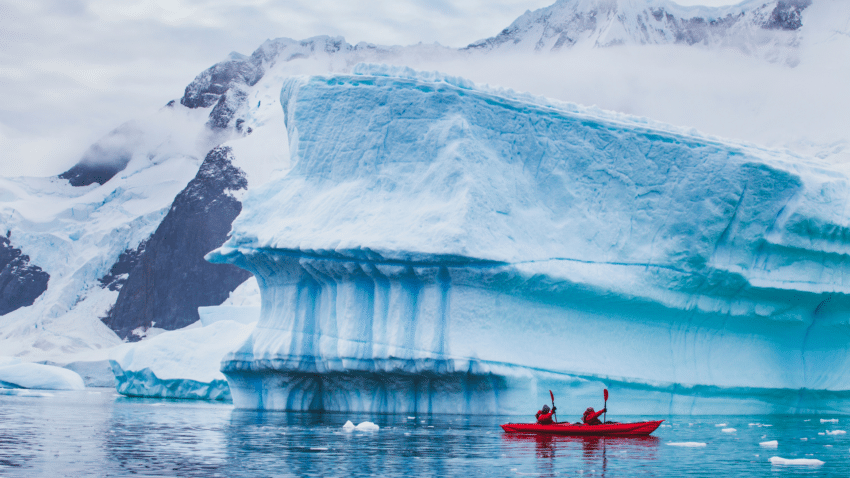
While it may sound like something out of the script for the TV show Westworld , frontier travel is a new travel trend for 2024 that takes travelers into wilder, more unusual destinations off the beaten track. This could mean grand adventures like following in the footsteps of great explorers across the Drake Passage to Antarctica or up Everest. Or it could mean taking a guided group trip to hike to and camp in a remote location or journey down a river by kayak or canoe.
These trips need a certain element of adventure and excitement, challenging travelers to get out of their comfort zone. This ties in with the transformational trip trend above, as people seek experiences that they will not only remember forever, but that could change them forever.
11. Hush trips, workcations, and micro-cations
In our 2023 report we highlighted the trend toward “hush trips” (when remote workers take a workcation without telling their boss) and workcations, when people travel abroad with the intention of combining a vacation with work. This kind of travel continues to be popular, and accommodation providers—from hotels to Airbnb apartments—often boast of dedicated work areas and other facilities for remote workers.
Many such trips are “micro-cations,” short trips often taken close to home, often at the last minute. The micro-cation trend has continued to grow for the last few years, as people look for quick, convenient, and often budget-friendly getaways that don’t require a lot of planning. When you combine the acceptance of remote working among many more employers with a large number of people who left the office behind and didn’t miss it for a second, you have an opportunity to create workcation and hush trip experiences for digital nomads and remote workers.
12. Traveling for “bleisure”
The tourism industry and travel press do love a good old portmanteau to describe the latest trend. Hot on the heels of workcations, the related trend of “bleisure” shows no sign of letting up. Bleisure is a name coined to describe the trend of business travellers tacking on some leisure time to the end of business trips or just taking their family along with them. Where a workcation is often a longer trip designed around work, the growth of bleisure trips reflects the fact that as business travel bounces back, people still want as much vacation time as they can get.
Deloitte’s “2024 travel industry outlook” report found that corporations are more concerned with costs than COVID now, but “trips to build client relationships and support team collaboration remain key to business success.” In fact, the report found that “US corporate travel spend is still likely to finally pass the pre-pandemic line within the next year.”
13. Set-jetting
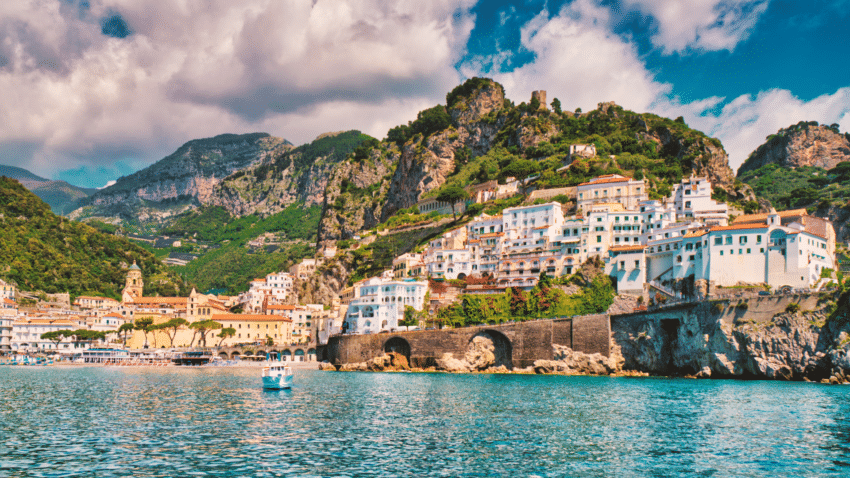
If you’ve ever wanted to visit the set of your favourite movie or TV show, you’re not alone. A top travel trend for 2023 that is continuing in 2024 is “set-jetting,” when travelers visit destinations primarily because they were featured in a popular movie, TV show, or book. According to research, 39 percent of travelers have booked trips to places featured on shows or movies ( Expedia ). While people have long been drawn to iconic movie locations, perhaps the earliest example of mass set-jetting was New Zealand’s tourism industry getting a huge boost after the country played a leading role in the “Lord of The Rings” movies. Fans of the “Outlander” books and TV series have also been making pilgrimages to Scotland to see the country that provides the backdrop for their favourite show.
People don’t just want to visit the actual physical set and filming location, but also just the cities or countries featured in a particular production. Popular shows where the location is as much the star of the show as the actors, such as “The Crown” (England,) “Emily in Paris” (Paris,) and “The White Lotus” (Sicily), have been credited with triggering a surge in demand for particular locations and experiences relating to the shows, such as a themed tour. And tour companies like Black Tomato have jumped on the trend to offer set-jetting itineraries .
14. Destination dupes
The economic upheaval we saw through 2022 and 2023 looks set to continue through 2024, . Inflation and cost of living rises mean while the desire to travel is still strong, many travelers will still have at least one eye on their budget. This has led to a new trend called destination dupes, when people seek out trips to locations that offer similar experiences to well-known or preferred locations, but that are more cost-effective.
Hotel giant Marriott commissioned a survey of over 14,000 travellers , and over 25 percent said they were choosing destination dupes in 2024. Examples of dupes include someone who lives in the US choosing a Canadian lake resort over an Italian Lakes destination. Here’s a good guide to popular holiday swaps for 2024 .
15. Coolcations
In the wake of rising temperatures and an increase in the number and intensity of wildfires in parts of North America, Europe and around the world, keeping cool is likely to be top of mind for many travelers in 2024—even among those who typically seek out the sun for their vacation.
Enter the “colocation.” Marriott’s survey found that over half of respondents would be considering climate change when planning their trips. Fifty-six percent said they were more interested in cooling down than baking in the sun. This makes areas like northern Europe a popular destination dupe as people look for similar attractions, such as culture, scenery, etc., to the hotter locations they might have chosen in the past but with a cooler climate.
16. Gig tripping
Just as the trend of people taking trips to sports and other events has grown, so too has this travel trend that is music to the ears of the travel industry. For example “swifties” from around the world are flocking to Taylor Swift concerts abroad, especially if tickets in their home country, especially the US, are hard to come by. CN Traveler called this the Swift Effect, as people travel to one-off gigs to see their favourite performer, as well as established (Glastonbury in the UK and Coachella in the US) and new (Untold in Romania) multi-day music festivals.
17. Sleep retreats

As we highlighted in our 2023 trends, everyone likes a good night’s sleep, especially on vacation, and the travel industry is waking up to the opportunities offered by a rise in “sleep tourism.” This trend continues to grow. Some travelers simply want a relaxing holiday with a comfortable bed and in an environment conducive to getting plenty of rest. For example, the Park Hyatt New York offers a stay in their One Bedroom Sleep Suite by Bryte . Others are taking advantage of a growth in technology geared towards helping people get their eight hours a night, and are booking “sleep retreats.” Swedish bed brand Hastens opened a branded Sleep Spa , and the HOTEL de LËN offers guests a “regenerative sleep experience.” Good night, sleep well.
These are just a selection of travel business trends for 2024 that could open up new opportunities for your tour business. For example, we haven’t even touched on how technology is changing the travel industry. And don’t forget traditional travel experiences, or in-destination activities. The Arival report highlighted that sightseeing tours, “hop-on, hop-off” experiences, and other tried and tested travel experiences and ways of seeing the sights are still going strong.
How to take advantage of innovative tourism business ideas
In an ever-evolving landscape of travel and tourism, the trends for 2024 reflect a desire for authenticity, sustainability, and immersive experiences. From eco-conscious adventures to culinary escapades and everything in between, travelers are spoilt for choice when it comes to exploring the world in new and exciting ways. Embracing these trends promises to enrich the travel experience and create lasting memories for adventurers of all kinds.
The key to taking advantage of these innovative tourism business ideas and other tourism industry trends is to always be thinking of your next profitable business opportunity. Here are a few ways to keep on top of what’s new and interesting in the travel business:
Maintain an ideas file
Include those “out there” trends that seem absurd the first time you hear them. Think about some recent innovations that would have been dismissed with a laugh not that long ago: Self-driving cars, passenger space travel, drone deliveries… Even that Holy Grail of futuristic inventions, the personal jetpack, is getting closer to reality. All but the most outlandish trends are worth tracking in case there’s a germ of an idea for a new business opportunity in there.
Listen to your audience
Hang out in online travel discussion forums, on social media, and in other places where travelers gather to swap notes and ideas or express needs and dreams. You might uncover a new business idea no-one else has come across yet.
Follow your competitors
Monitor what your direct competitors and others in the tourism business are up to. Subscribe to every industry newsletter you can, including those of your competitors, to keep up with emerging trends and help with your business idea generation.
Solicit customer feedback
Be proactive in asking your customers for feedback. Don’t just ask them what they liked and didn’t like about their experience with your company; ask them if there’s anything they would like to do that they currently can’t.
Invest in the right booking system

It goes without saying that every tour operator should offer online booking and take a mobile-first approach. Not doing both of those things makes taking advantage of the above trends very difficult. The customer experience starts the moment they enter your website. Online booking enables them to easily browse, book, and pay for tours anytime and from is anywhere. Learn more about how Rezgo booking software is tailor-made for adventure companies.
At Rezgo, we always have our ear to the ground when it comes to the latest tourism trends and business opportunities. The Rezgo booking system is a comprehensive platform that enables you to become a more

Written By | Rob Mathison
Rob Mathison is a Vancouver-based freelance writer focusing on tech, travel, digital marketing, and education. He is a co-author of The Complete Resident’s Guide to Vancouver.
Previous Article Promoting Travel Products With Google Things To Do
Next Article Rezgo Update 12.15: Powered Up Price Tiers, Meta Pixel Tracking, And More
Related Posts

Articles , Increase Online Bookings , Tourism Trends
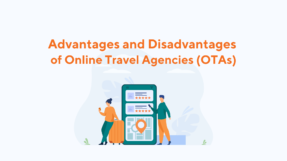
Articles , Increase Online Bookings , Tourism Best Practices
Advantages and disadvantages of online travel agencies (otas).

Articles , Increase Online Bookings , Marketing Strategies
Your marketing mix: the 7 ps of travel and tourism marketing, search the blog.
- All Categories
- Tourism Trends
Most Popular Articles
- 17 Innovative Tourism Business Ideas and Trends for 2024 118 views
- Advantages and Disadvantages of Online Travel Agencies (OTAs) 54 views
- Your Marketing Mix: the 7 Ps of Travel and Tourism Marketing 30 views
- How to Create and Promote Amazing Tour Packages 21 views
- How to Create a Business Plan for Your Tour or Travel Company 11 views
I have read and agree to the Rezgo Privacy Policy
GET STARTED
Sign-up for a free demo.
Lorem ipsum dolor sit amet, consectetur adipiscing elit, sed do eiusmo tempor incididunt ut labore et dolore magna aliqua.
Schedule A Demo
- Azerbaijani
- Chinese (Simplified)
- Chinese (Traditional)
- Haitian Creole
- Kinyarwanda
- Kurdish (Kurmanji)
- Kurdish (Soranî)
- Odia (Oriya)
- Scots Gaelic
WA Industry Link: Exemptions from WAIPS requirements
The WAIPS Portal is live from 1 July 2024.
The Western Australian Jobs Act 2017 allows conditional exemptions from the requirement of each prospective supplier to submit a participation plan when they are tendering for a WAIPS supply. Exemptions are to be granted by the Minister for State Development, Jobs and Trade (Minister for Jobs) or the delegated authority on either a case-by-case basis or as a standing exemption in relation to a prescribed class or circumstance of a WAIPS supply.
As part of an agency’s procurement planning, a minimum of 15 working days is required for the Department to process an exemption application. Exemptions must be approved before a tender is released and no retrospective applications will be granted.
An exemption may result in a participation plan no longer being required but reporting on workforce including apprenticeships and traineeships will still be required and a condition of the exemption provided.
A list of granted exemptions is available on the WA Industry Participation granted exemptions page.
Standing exemptions
Standing exemptions are available to agencies when there are frequent or repetitive procurements which align with one exemption category. This process reduces the administration process by removing the requirement for participation plans (exemption process) and repetitive single exemption applications.
Request a standing exemption
A standing exemption request must be submitted via email to WA Industry Link. If approved, management of the exempt supplier’s contract is completed through the WAIPS Portal. Follow the steps below to submit a standing exemption request:
- Prepare a Standing Exemption Application Letter using the online template.
- Email the completed application letter to the WA Industry Link.
- WA Industry Link will review the application and respond within 15 working days. If you have not received a response within this timeframe, please contact the WA Industry Link.
- If approved, record exempt tenders in the WAIPS Portal via the Apply for a Participation Plan Exemption form.
Case-by-case exemptions
Case-by-case exemption requests and the management of exemption and exemption reports must be done through the WAIPS Portal. For WAIPS Portal support on exemptions, visit the agency user guide.
Exemption eligibility
Exemptions are classified into categories and the category of exemption being sought is included in the exemption request. The below list provides further guidance on the typical exemption requests. The list is not exhaustive, and there will be unique circumstances pertaining to an agency and its WAIPS supply that are not covered in this list. In these circumstances, further advice can be sought from WA Industry Link.
Classified and sensitive
Procurement that contains information requiring protection and security because it has or could have an impact on national interest, including:
- National security – protection from espionage, sabotage, politically motivated violence, promotion of communal violence, attacks on Australia’s defence system, acts of foreign interference and the protection of Australia’s territorial and border integrity from serious threats.
- International relations – significant political and economic relations with international organisations and foreign governments.
- Law enforcement operations where compromise could hamper or make useless crime prevention strategies or particular investigations or endanger personal safety.
- Classified and sensitive examples include but are not limited to the procurement of firearms, emergency services procurement in relation to counter-terrorism.
Overseas expertise in specialised equipment
- The acquisition of specialised equipment that is not manufactured in Australia; and
- Where the acquisition is 90% or greater of the estimated contract value. Examples include medical equipment such as MRI machines and some specialised industrial vehicles.
Sole source
- Where there is only one known source for supplies or services as determined by documented research.
- No other reasonable alternative source exists that meets the procurement agency’s requirements.
- Only one source meets the needs of the procurement agency. Examples include systems/product maintenance (e.g., additional licences, updates, replacement parts); information technology; and laboratory equipment.
Must be performed in Western Australia
- Where the nature of the procurement must be performed within Western Australia; and
- Estimated local participation is at 90% or greater.
- There is little or no variation anticipated between offers to supply. Examples include contract for cleaning a school or office building; contract to provide gardening services.
Must be performed overseas
- A small number of procurements are for overseas services. Examples include maintenance of an overseas office and tourism marketing in overseas markets.
Unique Circumstances
- Where the procurement doesn’t fit one of the defined categories, but the agency is able to demonstrate that there will be little or no benefit to the state to request a participation plan as part of the procurement process.
Common Use Arrangements (CUAs) and Agency Panel Arrangements
- Agencies must formally seek an exemption for the head agreement so that prospective suppliers will not be required to include a participation plan as part of their offer to establish the arrangement.
- A further instance is an agency purchase of a basic utility service such as gas, water and electricity.

Related information
- WA Industry Link
- WAIPS Portal
- Information about WAIPS
- WAIPS Portal guide for agencies
- WAIPS Portal guide for businesses
- Stakeholder toolkit
Provided by
WA Industry Link Telephone: 61 8 6277 2999 Email: [email protected] WA Industry Link website
- Facebook share (Opens in a new tab/window)
- Twitter (Opens in a new tab/window)
- LinkedIn (Opens in a new tab/window)
Acknowledgement of Country
The Government of Western Australia acknowledges the traditional custodians throughout Western Australia and their continuing connection to the land, waters and community. We pay our respects to all members of the Aboriginal communities and their cultures; and to Elders both past and present.

IMAGES
COMMENTS
As travel resumes and builds momentum, it's becoming clear that tourism is resilient—there is an enduring desire to travel. Against all odds, international tourism rebounded in 2022: visitor numbers to Europe and the Middle East climbed to around 80 percent of 2019 levels, and the Americas recovered about 65 percent of prepandemic visitors 1 "Tourism set to return to pre-pandemic levels ...
2022 National Travel and Tourism Strategy. Focuses federal efforts to support travel and tourism in the United States. Establishes a five-year goal of attracting 90 million visitors, who will spend $279 billion annually. Envisions private and public sectors working together to increase the volume and value of tourism.
The outcomes demonstrate diverse strategies for implementing sustainable innovation in the field of tourism, along with recommendations for future implementation across various tourism sub-sectors. These findings underline the importance of introducing sustainable innovations that foster sustainable development through collaborative efforts ...
Innovation in tourism, as elsewhere, is collaborative action between governments, academia, corporations, micro, small and medium enterprises (MSMEs) and start-ups, investors, supporting business partners (accelerators, incubators, etc.) and other stakeholders. Fostering a successful tourism innovation and entrepreneurial ecosystem requires ...
Our global innovation ecosystem is now made up of more than 12,000 start-ups from 160 countries, with US$83 million mobilized and 300 corporate partners currently working on new tourism technologies. And UNWTO's education programmes are reaching unprecedented numbers of people, welcoming more than 20,000 students from 100 countries in just 18 ...
In conclusion, this systematic literature review provides an up-to-date review of tourism innovation research and an agenda for future research that addresses the nexus of small and micro enterprises and innovations, eco-innovations and the interplay between governance and innovations. 1. Introduction.
In this paper, we analyze the progress of tourism towards sustainability and innovation through a systematic literature review summarizing the last five years of research strictly focused on innovation and sustainability applied to tourism. This research comprises a range of theories, practices, methods, and results pursuing innovation and sustainability across different levels, stages, and ...
This book analyzes the importance of innovation as the key driver of sustained success in the tourism industry and the knowledge sharing process. It explores its impact on innovation capability and innovation performance of organizations. With 12 chapters written by 22 contributors, the book offers international reflections.
The federal government will work to implement the strategy under the leadership of the TPC and in partnership with the private sector, aiming toward an ambitious five-year goal of increasing American jobs by attracting and welcoming 90 million international visitors, who we estimate will spend $279 billion, annually by 2027.. The new National Travel and Tourism Strategy supports growth and ...
A joint effort by UNWTO, UNDP and other partners, Tourism and the Sustainable Development Goals - Journey to 2030 aims to build knowledge, and empower and inspire tourism stakeholders to take necessary action to accelerate the shift towards a more sustainable tourism sector by aligning policies, business operations and investments with the SDGs.
Along with innovation, tourism is another important input factor contributing to growth and development. The era of post-WWII saw great progress in national and international tourism where better living conditions, higher income, improved and better transportation, and longer holidays with low travel costs are all the reasons for the world to ...
Tourism rose to the forefront of the global agenda in 2020, due to the devastating impact of COVID-19; Recovery will be driven by technology and innovation - specifically seamless travel solutions, but it will be long, uneven and slow; Success hinges on international coordination and collaboration across the public and private sectors
The Strategy focuses on U.S. government efforts to promote our nation as a premier destination grounded in the breadth and diversity of its communities, and to foster a travel and tourism sector that drives economic growth, creates good jobs, and bolsters conservation and sustainability. Drawing on engagement and capabilities from across the ...
Innovation Map outlines the Top 9 Travel Trends & 18 Promising Startups For this in-depth research on the Top 9 Trends & Startups, we analyzed a sample of 18 global startups and scaleups. The result of this research is data-driven innovation intelligence that improves strategic decision-making by giving you an overview of emerging technologies ...
scroll. The Hospitality Innovation Industry Report, authored by EHL Associate Professor Dr. Carlos Martin-Rios, is based around a comprehensive model reviewing combinations of technological and non-technological innovations and analyzes how different innovation strategies contribute to generating competitive advantages for hospitality businesses.
Travel and tourism is a critical driver of economic growth and employment in the United States and integral to the United States' unmatched cultural reach.¹ Supporting some 9.5 million American jobs through $1.9 trillion of economic activity, travel and tourism is an engine of prosperity and opportunity in communities across the country - from the bright lights and bustling streets of the ...
Tourism can play a huge part in achieving the SDGs and UN Tourism is committed to provide the global tourism community with a space to come together and realize the 2030 Agenda. ... Sustained investment in infrastructure and innovation is a crucial driver of economic growth and development. ... The sector is in a strategic position to foster an ...
The Tourism Technology and Innovation Roadmap supports more tourism businesses to adopt technologies and be more innovative in their tourism experience, service delivery and business sustainability. By 2032, Queensland will have a high-functioning tourism network operating as an effective partnership model built on evolved technology strategies ...
News release. New strategy will foster growth and competitiveness of the tourism industry. July 4, 2023 - Niagara, Ontario. Tourism powers the Canadian economy, creating good jobs in every region of the country, from rural and remote communities to the largest cities. Tourism is also highly inclusive. Compared to other sectors, it employs a ...
Strategic innovation is a future-focused business development framework that identifies breakthrough growth opportunities, accelerates business decisions and creates a near-term 28 fInnovation Strategies in Tourism industry impact within the context of a longer-term vision in order to get a competitive advantage. (S.
Since innovation in the Tourism Sector can be understood as creativity and new ways of thinking, synthesizing results of previous research is one of the most important tasks for the advancement of a specific line of research. ... In addition to their systematic literature reviews involving regional innovation strategies in culinary tourism ...
Innovation, Education and Investments. In order to anticipate, address and overcome the new challenges and trends of the Tourism sector, the World Tourism Organization is currently focusing on a strategy on Innovation, Education, Digital Transformation and investments. Harnessing innovation and digital advances provides tourism with ...
13. Set-jetting. If you've ever wanted to visit the set of your favourite movie or TV show, you're not alone. A top travel trend for 2023 that is continuing in 2024 is "set-jetting," when travelers visit destinations primarily because they were featured in a popular movie, TV show, or book.
About. The Western Australian Jobs Act 2017 allows conditional exemptions from the requirement of each prospective supplier to submit a participation plan when they are tendering for a WAIPS supply. Exemptions are to be granted by the Minister for State Development, Jobs and Trade (Minister for Jobs) or the delegated authority on either a case-by-case basis or as a standing exemption in ...
The managers of Uganda's economy say its growth strategy is anchored on four key growth drivers; agro-industrialisation, tourism, mineral development, including oil and gas; plus innovation. But...